Zagreb County Tourist Board: Green and Sustainable, Like Us, is the Way
September 4, 2022 - Director of the Zagreb County Tourist Board, Ivana Alilović, spoke in the Novi Dan program of N1 television about the tourist season in her county. Zagreb County as a year-round destination, she said, has exceptional results.
As Index writes, they reached the level of 89 percent of 2019 as far as arrivals are concerned, but they have exceeded overnight stays by one percent.
She pointed out that the camps proved to be good destinations to go to. She cited the example of Sveta Nedelja, as well as the area of Velika Gorica, which has the most hotels, and Plešivica proved to be a good combination not only for the wine story, but also for a safe stay in nature.

Zagreb County Tourist Board
Alilović added that more than 90 percent of arrivals are individual. She highlighted the arrival of tourists from Scandinavian countries.
Not a mass destination
"More and more tourists are coming looking for green and sustainable, and we have that. We try to capture the element of sustainability with the activities and European projects we implement. We are not a mass destination and I don't think we will ever be".
"The coexistence of our residents is important to us, what they can invest and get out of it. We will try to nurture the tradition found here," said Alilović. She added that they are moving towards offering quality to every guest and creating sustainability. "This is a big difference compared to previous years. It is important that we stand behind what we offer," she emphasised.
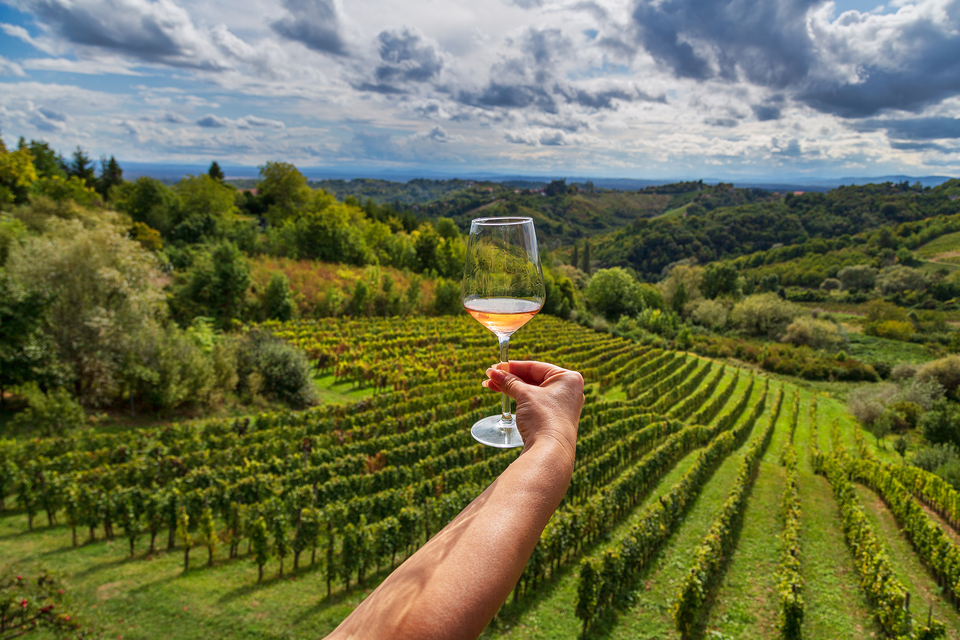
Zagreb County Tourist Board
They are promoting the project "From farm to table". There are more than 14 thousand OPGs in the area of Zagreb County. She believes that all those who taste Zagreb dishes will return. Via Vino, Alilović added, is an award-winning event which opened the the doors of the county's wineries for the second time. In order to become an attractive destination, they also introduced attractive events such as a movie theater under the stars in the vineyards.
For more, make sure to check out our dedicated Lifestyle section.
Croatia Through the Eyes of a Digital Nomad: Filling up on Ancient Poljička Soparnik
May 6, 2022 - If you’re culturally curious and hungry in Split, sample Poljička soparnik and savor some remarkable history to satisfy your craving.
An ancient Croatian republic is ruled by a book of statutes that includes protections for women and dogs. A young heroine sacrifices her virginity to seduce a Turkish general and then blow up his Ottoman army, thereby saving the republic. Pirates troll the Adriatic, along the republic’s seaside territory. Books are written in Glagolitic letters, the oldest known Slavic script. Priests cast the deciding vote to determine who will reign as the next publicly elected Great Duke. All citizens of the republic are free and literate, and they all go into battle.
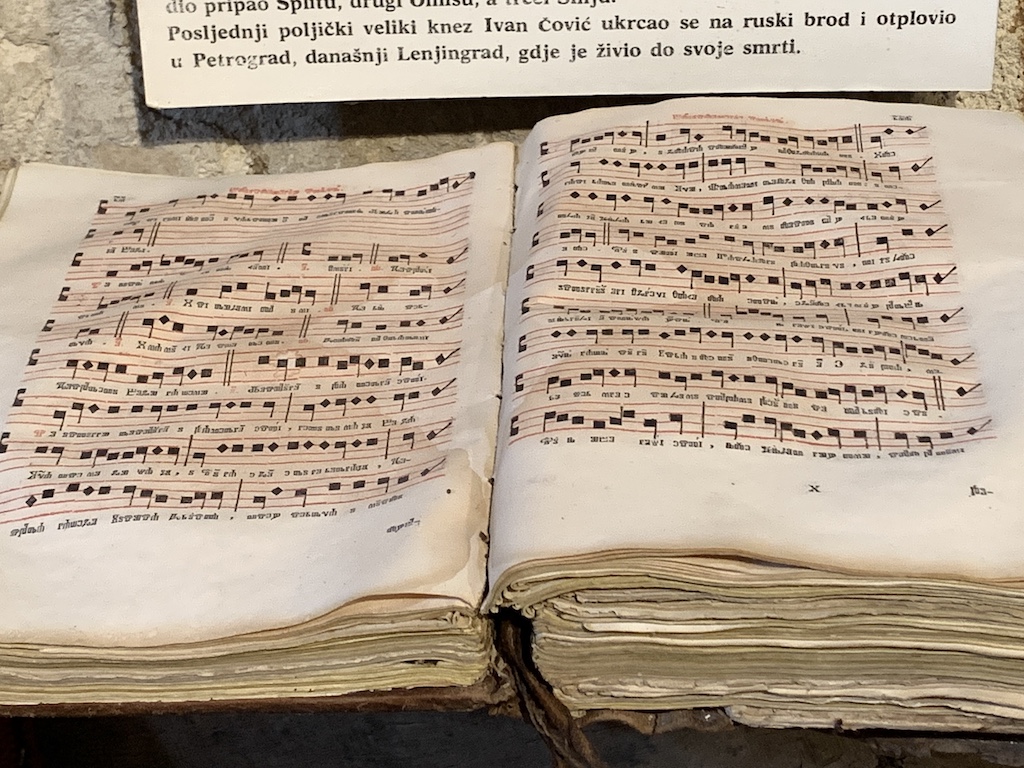 A book preserved from the early days of the Republic is written with the old Glagolitic letters.
A book preserved from the early days of the Republic is written with the old Glagolitic letters.
Poljička Republika
Still with me? Welcome to the Middle Ages and the Poljička Republika, an autonomous community that existed on the land between Omiš and Split for nearly 700 years. This peasant community was self-ruled with an original legal system, a progressive social structure, and independence from the rest of the country. The people’s values are the secret sauce that kept them unified and helped them survive throughout centuries, and boy oh boy do they make an impression.
 A picture of a picture… a statue of Mila Gojsalić, the young Poljica heroine who helped defeat the Ottomans stands above Omiš; carved by Croatian sculpture Ivan Meštrović.
A picture of a picture… a statue of Mila Gojsalić, the young Poljica heroine who helped defeat the Ottomans stands above Omiš; carved by Croatian sculpture Ivan Meštrović.
Today, their exclusive costumes, novel dance, and unique songs are recognized on UNESCO’s list of Intangible Cultural Heritage. And here’s the culinary piece you’ve been waiting for… The people’s traditional “peasant food,” soparnik, is on the list too and it’s furthermore protected by geographic origin per the European Union. Wow.
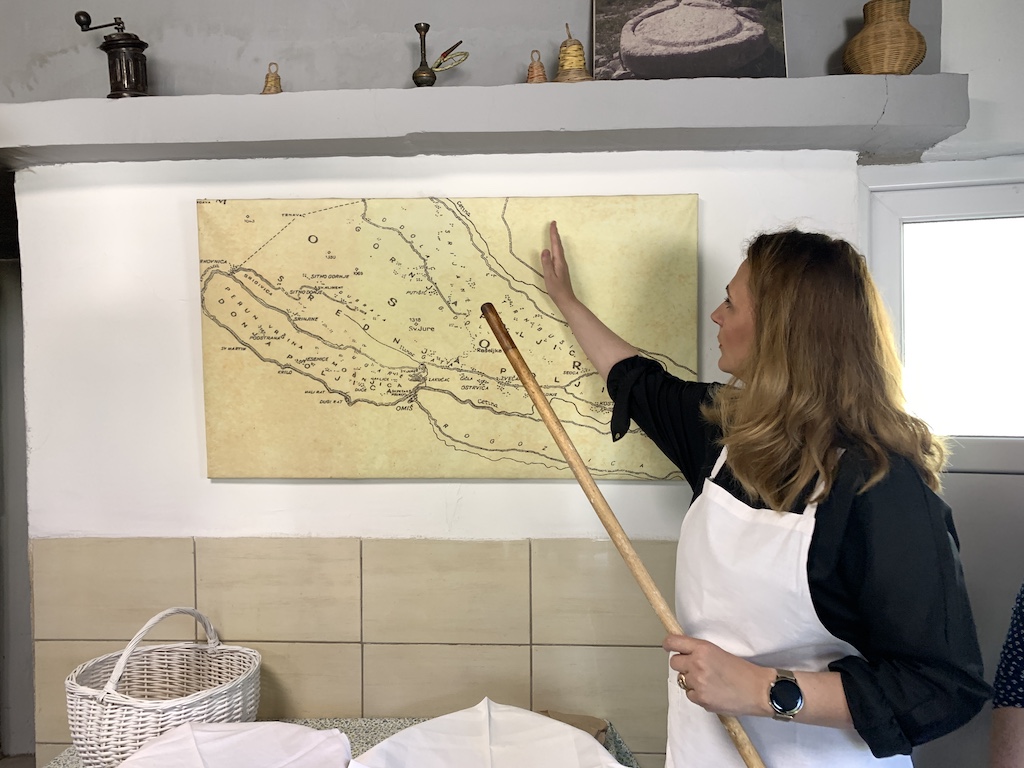 This village kitchen displays a map of the Poljica region, here showing where the Upper, Middle, and Lower territories of the Republic sit around Mosor Mountain.
This village kitchen displays a map of the Poljica region, here showing where the Upper, Middle, and Lower territories of the Republic sit around Mosor Mountain.
Soparnik pie
The humble soparnik pie is a standout for its simplicity and its deliciousness and it’s possibly the best cultural ambassador for the ancient Republic and the current Poljica region. Once considered basic grub for the poor and workers, dating back to the Ottoman Empire, it’s still made from locally grown ingredients in the customary manner of the hinterland, including wooden equipment and an open stone oven.
 A massive oak tree near the Church of St. Cyprian grew up during the heyday of the Poljica Repubic and is thought to range from 400-700 years old.
A massive oak tree near the Church of St. Cyprian grew up during the heyday of the Poljica Repubic and is thought to range from 400-700 years old.
Soparnik is easy and quick enough to make and it consists of flour, water, salt, olive oil, chard, onion, and garlic. So particular are the cooks, they can tell you the difference between onions grown in their back yard versus those on the other side of the mountain. With so few ingredients, this skill is a testament to the resourcefulness of people with little means, using their natural surroundings to create sustenance, which, by the way, happens to be quite tasty and filling.
In the kitchen
In family homes, Grandma Milka teaches granddaughter Mila precisely how to roll the dough on a sinija—a round wooden board that measures 90-110 cm in diameter (35-43 inches)—to get a perfect, thin consistency. She also mentions that the blitva (chard) needs to be dried after being washed so the dough won’t get soggy.
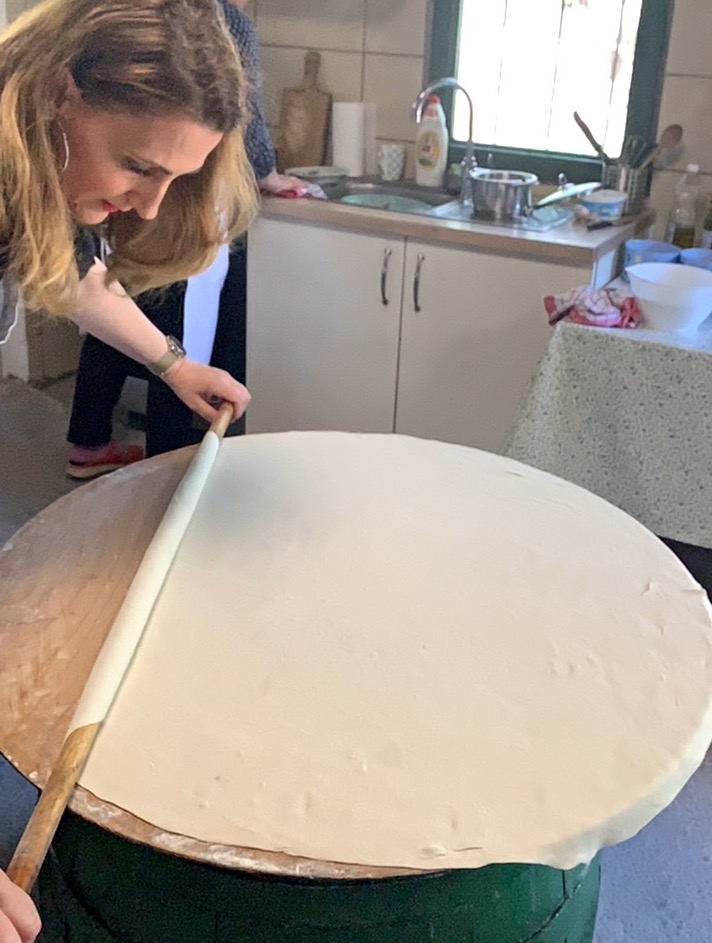 A wood stick and a large wood platter are the basic kitchen equipment for rolling dough.
A wood stick and a large wood platter are the basic kitchen equipment for rolling dough.
If you noticed the similarity of their names, that’s intentional. Boys’ and girls’ names are derived from their grandparents, per an old-world practice that’s still carried out.
Embers and ashes
Back in the kitchen… once the first layer of dough is covered with the vegetable mixture, a second layer is placed on top and the pie is sealed with a braided edge; ready for the oven. Then the massive soparnik is slid off the sinija and onto the hot stone. The next step made me gasp, it was covered with embers and ash. No!
 Locally grown chard, a.k.a. blitva in Croatia, is the main vegetable inside soparnik and it’s carefully tripped to remove the hard stem so the thinly sliced pieces cook evenly.
Locally grown chard, a.k.a. blitva in Croatia, is the main vegetable inside soparnik and it’s carefully tripped to remove the hard stem so the thinly sliced pieces cook evenly.
Baking this way for nearly 20 minutes, the pie cooks on top and bottom and picks up a subtle smokey flavor. I appreciated this nuance when I tasted a finished piece, which had the final touches—a coating of Dalmatian olive oil and a sprinkling of raw garlic.
Dalmatian specialty
This traditional Dalmatian specialty symbolizes a specific culture and a way of life. While you eat soparnik, it’s intriguing to let your mind wander back to the Poljička Republika and try and imagine an alternate scenario where somebody else ate the exact same thing, literally, in the same place, hundreds of years ago.
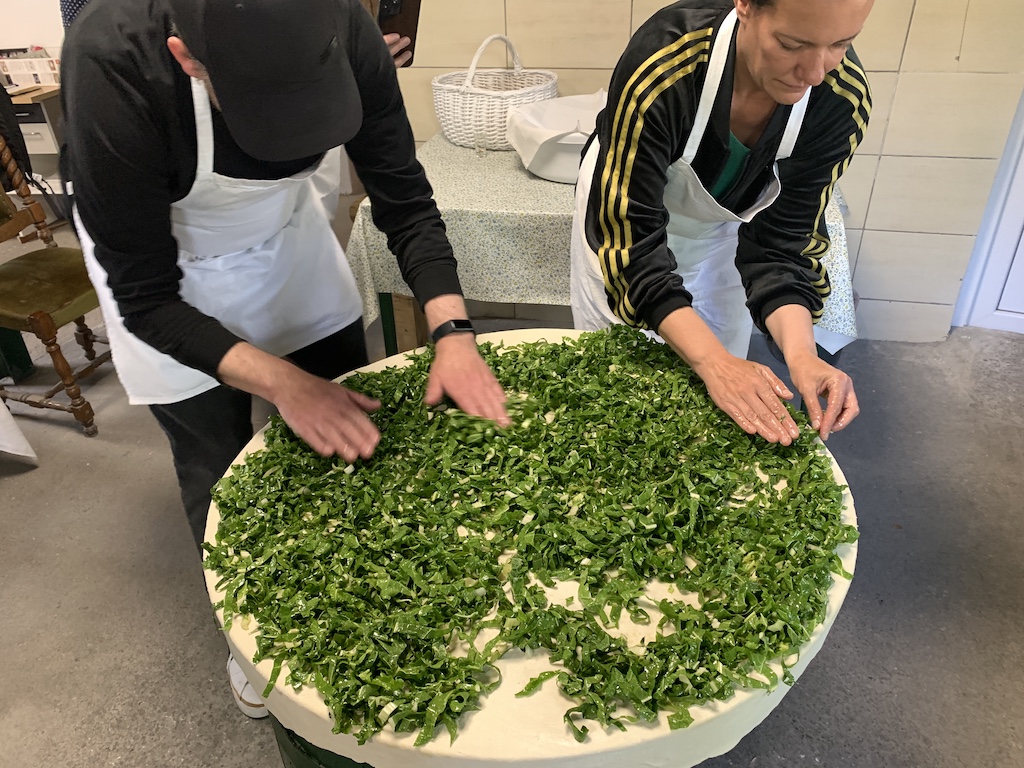 The pie stuffing of chard mixed with onion, salt, and olive oil is evenly spread on the thin layer of dough.
The pie stuffing of chard mixed with onion, salt, and olive oil is evenly spread on the thin layer of dough.
The EU protection helps to make that connection because it guarantees that the soparnik you buy from local markets and festivals is authentic from Poljica.
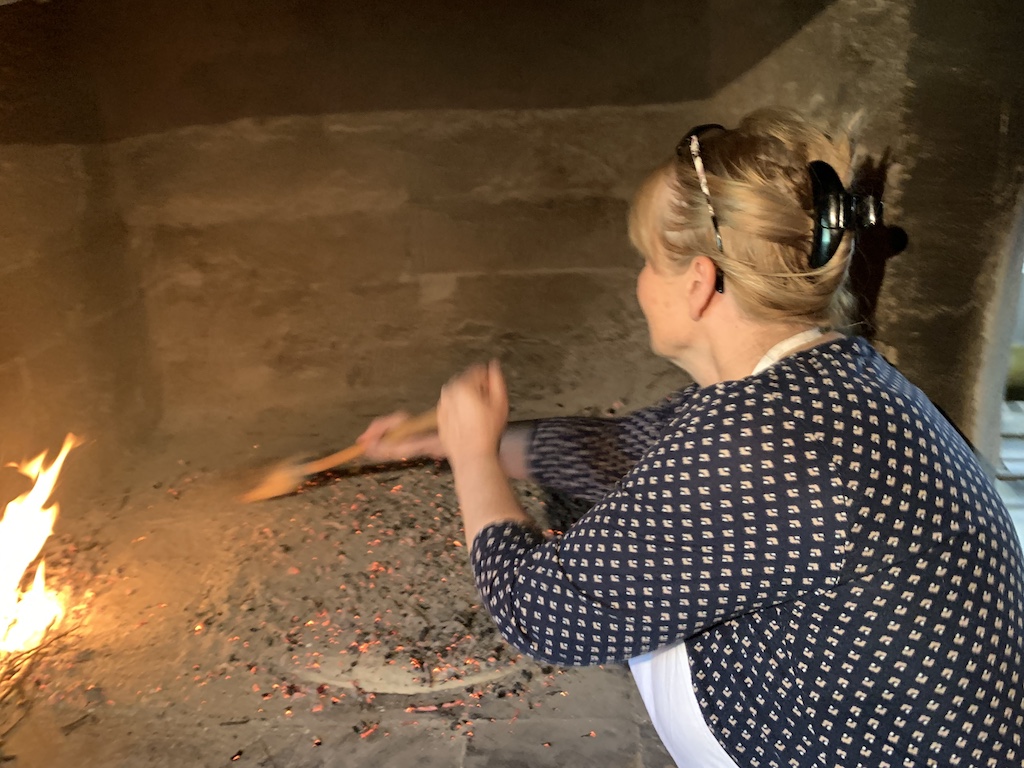 Magic happens in a hot stone oven when coal embers and ashes bake the top part of your soparnik and add a subtle smokey flavor.
Magic happens in a hot stone oven when coal embers and ashes bake the top part of your soparnik and add a subtle smokey flavor.
Pizza anyone?
So, if you’re now wondering about another national “pie,” here’s a fun fact. Legend has it that Venetians in Croatia who tasted soparnik back in the day took it home to Italy and it became the inspiration for pizza. What do you think? Dobar Tek!
This experience was another great authentic adventure organized by the Cromads travel club.
Story and photographs ©2022, Cyndie Burkhardt. https://photo-diaries.com
Learn more at TCN’s Digital Nomads channel.
Croatia Through the Eyes of a Digital Nomad: When Cro-Made Beats Store-Bought
December 7, 2021 - Abundant natural resources and a variety of locally-made products are Croatia’s secret to healthy living.
Before arriving in Croatia, I was traveling in many countries learning about wellness practices in different parts of the world. I’m interested in how people think about their wellbeing and what role culture plays. From temazcal in Mexico to a curandera in Colombia, Reiki in Japan, and more, I experienced a variety of indigenous modalities.
Once here, I looked for Croatia’s offer beyond the popular Mediterranean diet and the outdoor lifestyle. Initially, nothing seemed exceptional, but over time I noticed a pattern. Nature blessed Croatia with abundant resources and people are adept at cultivating them and producing goods. I’m talking about food, wine, rakija, and herbal, beauty, and medicinal products. It’s a way of life that a surprising number of people embrace; usually for personal/family use and often as a side hustle. While I can talk long about the (delicious) consumables, the plant-based treatments are equally intriguing.
Plant products
Hvar’s annual lavender festival was my introduction to Croatia’s natural, homemade products and the women who make them. Kantarion (St. John's Wort), smilje (immortelle), nevin (calendula), and of course lavanda (lavender) grow wild here and they’re main ingredients in various creams, balms, lotions, oils, and soaps. Numerous healing/soothing/preventative benefits can be derived from these plants. Commercial products containing these ingredients are sold around the world, but here you can find them made in kitchens and backyards—fresh, clean, and devoid of additives, preservatives, and unpronounceable chemical components.

Grapes grow abundantly near the Adriatic coast. The climate provides unique characteristics that help Croatian wines routinely win awards in international competitions.
What’s the big deal, you may ask? For starters, a lot of women know the plants here—where to find them, how to work with them, and how they keep the body and skin in good working order. Their healing remedies and beauty tonics are in the family medicine cabinet. By the way, have you noticed how many Croatian women have beautiful, supple skin? That brings me to the next point—these things work.
Here are two women with very different stories and motivations for getting into plants.
Hag Made

Ivana Magdalenić with some of her products at Hvar’s annual lavender festival.
Ivana Magdalenić made her first remedy eight years ago to help a friend with a foot injury. After lots of research and tinkering with a recipe, she found the right mixture that healed her friend’s wound. Ivana realized she had a knack for working with plants and she went on to create a natural product line that treats a range of issues—from acne to burns, wounds, scars, psoriasis, wrinkles, joint pain, and more.
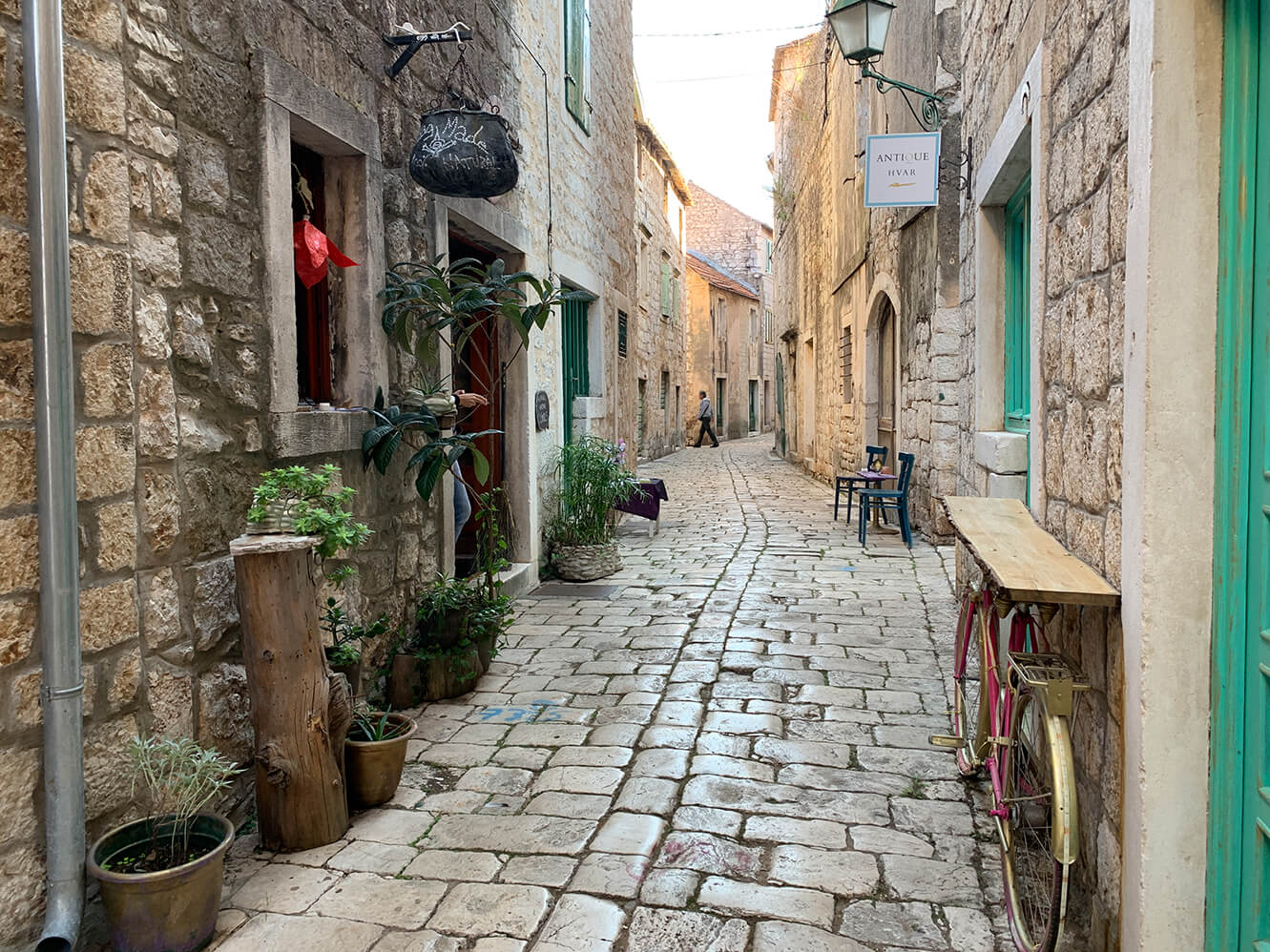
Ivana sells her complete line of Hag-Made products at her shop in Stari Grad, Hvar.
Her company name, Hag Made, is a charming wordplay on hand-made and was inspired by a dream about witches brewing over a cauldron. In this narrative, Ivana is a “good witch” who creates healing potions from the heart. I used her Kantarion Plus on some acute burns and within a few days I stared at my skin in disbelief at the marked difference in appearance along with the pain relief. Her Smilje cream gave my skin that Cro dewiness overnight.
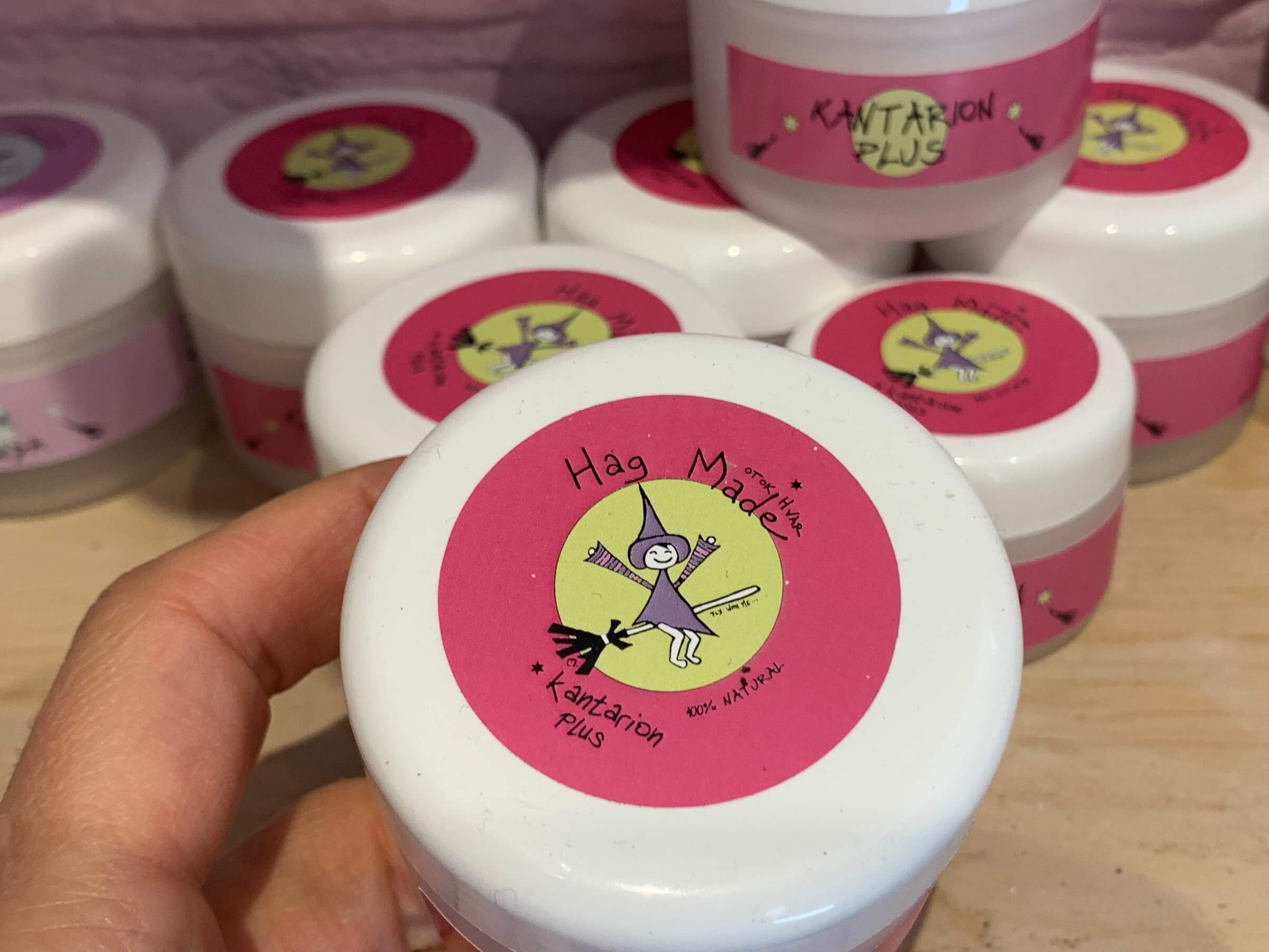
Hag-Made Kantarion Plus has strong anti-inflammatory properties and worked miracles on the author’s badly burned skin.
Everything Ivana uses grows naturally on Hvar, where she’s from, and she knows the difference between a plant that comes from the south side of the island where the sun is more intense versus plants on the north side. It’s an important distinction because product quality and effectiveness are priorities; nothing is sold without being tested. She’s part artist, musician, inventor, and free spirit who seems to have a special connection to the earth’s energy, which undoubtedly guides her business.
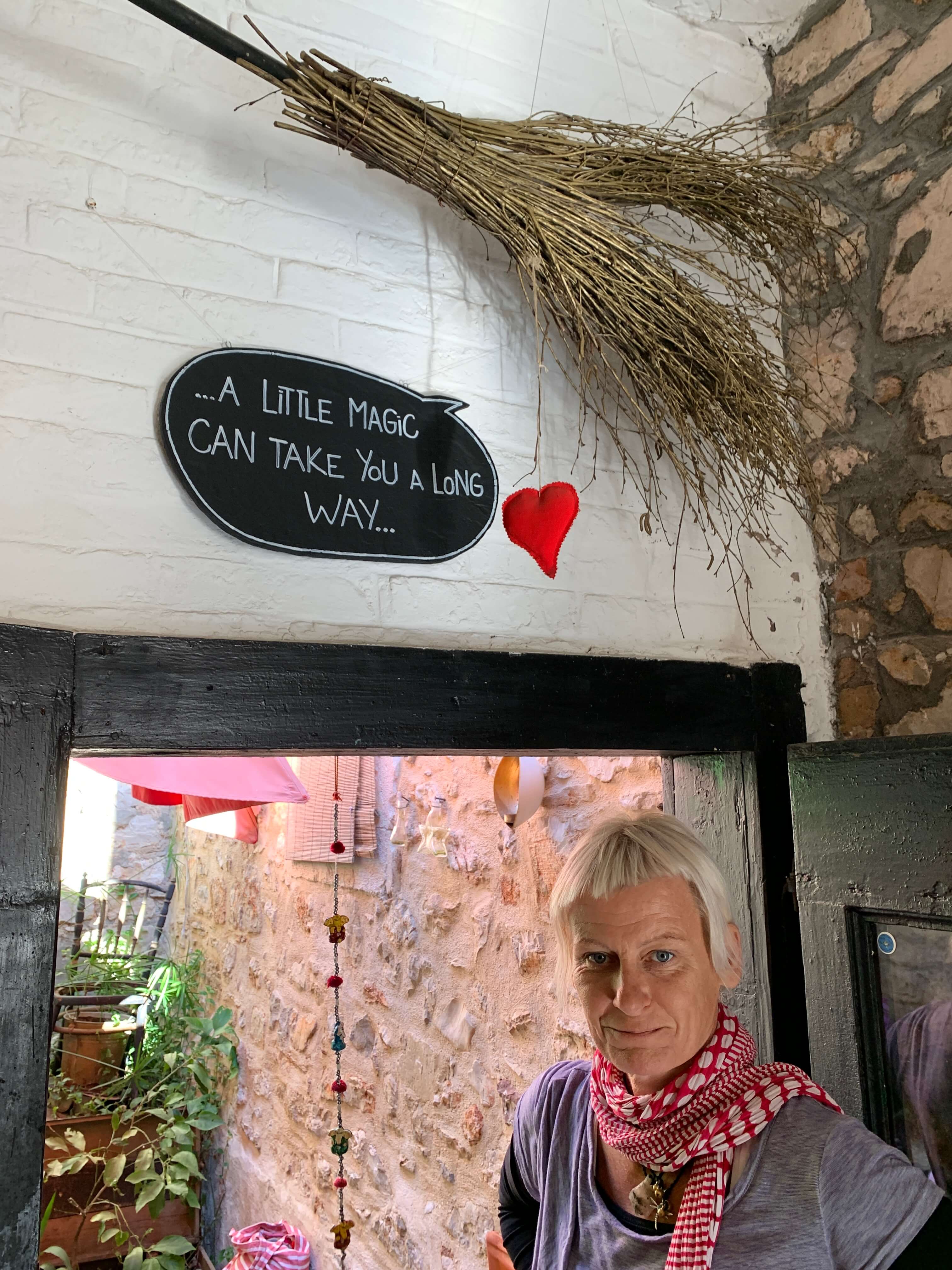
Ivana in her shop, near the door leading to the outdoor garden where she enjoys coffee and the company of friends.
Grandma Ruža
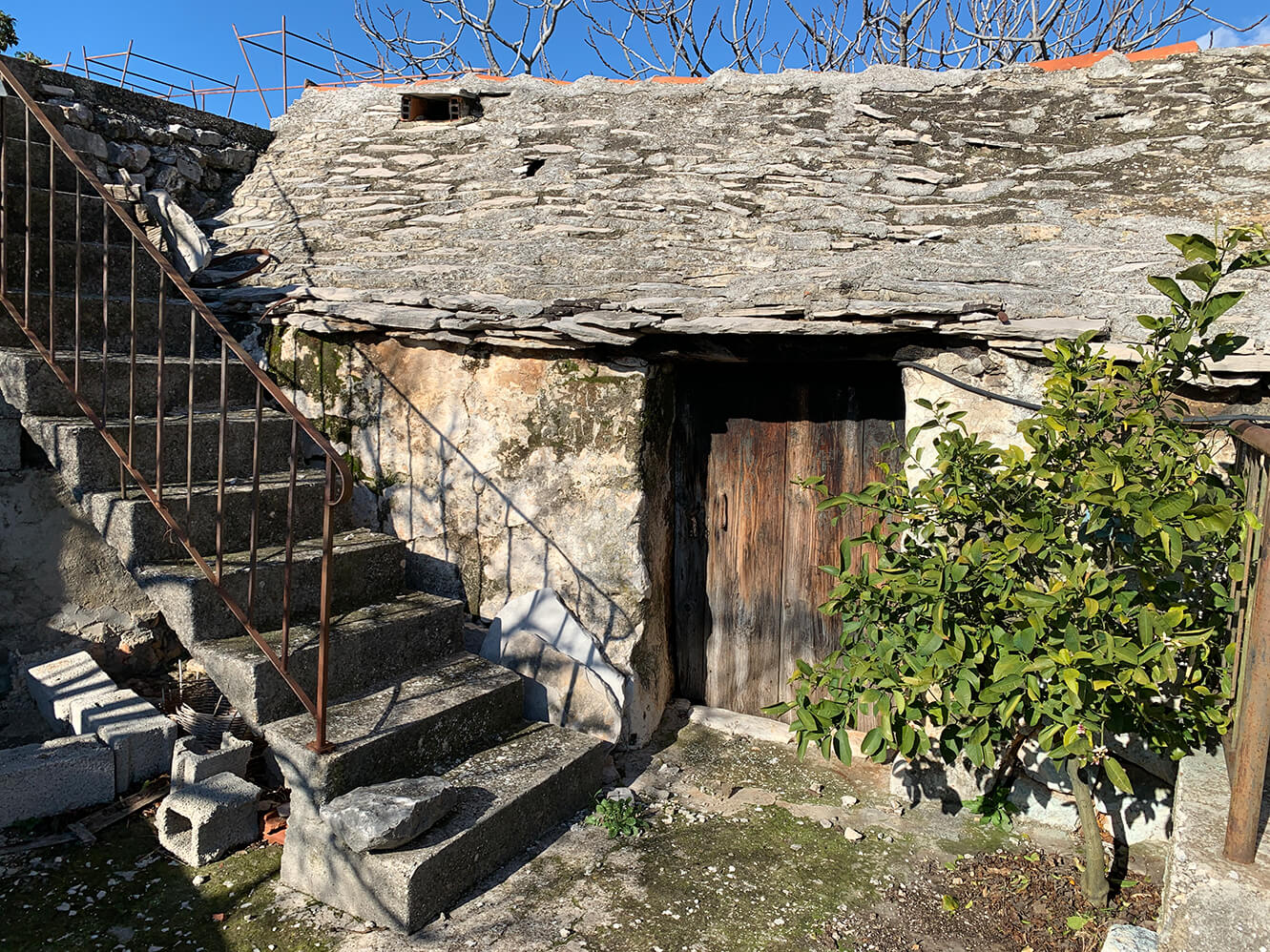
Grandma Ruža’s childhood house in Gustirna, near Trogir.
Conversations about healing often include somebody’s grandmother and Grandma Ruža is a queen. She’s been making oils and creams with kantarion, smilje, and nevin (calendula) for decades. She administers these for sunscreen, sunburn, wounds, hemorrhoids, cuts… for anything, she tells me. She’s been known to pan-fry dried chamomile flowers in olive oil to make chest wraps for reducing colds and inflammation, and she brews tea from various herbs to improve assorted ailments. To relieve her rheumatism, Grandma Ruža visits a secret location on Šolta where she smears the black mud on her entire body and face; home-made rakija infused with herbs helps too. Funny.

Grandma Ruža with a picture of her mother.
Her range of knowledge comes from life experience. Growing up at the end of World War II in the countryside near Trogir, people in the villages survived off agriculture. She was on the front line with her mother for handling plants and animals and producing a long list of food—meat, cheese, vegetables, oils, herbs, wine, and brandy. When Grandma Ruža quit school at age 10 to work and help take care of the family, her hands-on education on plant medicine began too.

Grandma Ruža cleaning up in the yard around her childhood home.
She regularly picked sage, immortelle, and wormwood, and tree fruits including oskoruša (used as medicinal tea for stomachaches and constipation) and maginje (a Croatian “strawberry” containing high amounts of vitamin C and dietary fiber)—some of the more direct healing plants. Today, she’s still going strong and the family still benefits from her preparations.

Recycled containers come in handy for Grandma Ruža’s homemade oils and balms, which the whole family uses.
Natural fortunes
Not many places in the world have Croatia’s diversity or abundance of natural resources that provide food, nutrition, and healing. I’m not sure how many Croatians realize their good fortune in this regard, but it seems obvious to me, and it feels like I’m constantly learning about a new food or plant here that provides some benefit.

Maginje fruit are called Croatian strawberries. Although the shape, texture, and taste are different from typical garden strawberries, their health benefits are similar. Unlike the garden variety that grows in plants low to the ground, maginje grows wild in trees and in great quantity.
To be able to produce food with readily available, indigenous vegetation, animals, and other means AND nourish your body (hello Mediterranean diet) AND heal your ailments, seems like a triple win. I’m glad to have found Croatia’s natural wellness; to my mind it enhances everyone’s prospects for healthy living.
For more of Cyndie's experiences, check out her Croatia Through the Eyes of a Digital Nomad column.
Are you an expat in Croatia who would like to share your experiences during the pandemic in Cyndie's video series? If yes, please contact her on This email address is being protected from spambots. You need JavaScript enabled to view it.
We are also keen to interview any digital nomads who have successfully applied for the new visa, after the first success in Istria - Meet Melissa Paul, Owner of Croatia's First Digital Nomad Visa. Please contact us on This email address is being protected from spambots. You need JavaScript enabled to view it. Subject Nomad Visa.
Nomad Rescue: New Croatian App Created as One-Stop Shop for Digital Nomads
November 30, 2021 - Nomad Rescue is a new one-stop web application for digital nomads, developed by Algebra University College graduate students.
A team of graduate students from Algebra University College, "The Nomads," has developed an application that makes it easier for digital nomads to navigate the country they have chosen while answering all practical and operational questions about life in the country, reports Index.hr.
There has been a lot of talk in Croatia to attract digital nomads to live and work in the country, which has been successfully implemented in terms of regulations that allow individuals in Croatia. Thus, Croatia became one of the first countries globally with such an elaborate program for attracting digital nomads.
It is this idea that the Algebra University graduate students decided to explore and expand in more detail, where an innovative project program has recently been implemented as a compulsory course in all graduate studies.
Students acquire entrepreneurial skills during this two-year graduate study program and go through a program similar to waiting for startups in each incubator; they also have mentors available to advise them. There are no exams, no tests, but each individual's contribution is evaluated as well as the overall team result - which together represents an innovative way of practical teaching that we have not had the opportunity to see so far.
A unique part of this project is that it brings together students from various graduate studies conducted by Algebra University - software engineering, digital marketing, and data science - so students meet with different skills and different previous education, who often did not have the opportunity to get acquainted earlier in their studies, which makes exchanging ideas, knowledge, and working on the project much more exciting and fun.
"Our motto is that students through this course should learn how to reach the goal - after that, each new endeavor is a step forward for them, and they have a clear feeling that they will succeed; it's just a question of when. In other words, it's just a matter of their persistence," emphasizes Maja Brkljačić, one of the course leaders and head of business development in the longest-lived and most relevant startup incubator in the country, Algebra LAB.
One-stop-shop for digital nomads
Seven members of the "The Nomads" had fun studying the lifestyle of digital nomads, which led to the idea of developing a web application, "Nomad Rescue," a one-stop shop for digital nomads. Their research of the problems digital nomads face has shown that it is challenging to relocate to another location for some. In contrast, for others, the situations they face after relocating are much more challenging.
Andro Žonja and Ivan Jakovljević, graduate students of software engineering, Nina Tudor, Marta Krznar and Filip Puljić, graduate students of digital marketing, and Antonio Akrapović and Mateja Novaković, who are studying at the graduate study of data science, designed an application that would quickly and efficiently offer nomads reliable information on various topics.
Nomad Rescue is designed as a social network that integrates a program to search for accommodation for longer stays. Its users will be able to use this social network as a tool to meet other digital nomads in their location and thus find roommates. It will also feature an accommodation search tool for those nomads staying for a more extended period and a module that students call a "virtual guide" that will allow users to integrate into the new environment more easily.
"It is a platform that tries to facilitate the selection of a new living environment, finding accommodation, reviewing the content offered by nearby locations, and meeting other nomads through the social network," explains Ivan Jakovljević.
"I came up with the idea almost a year before we started this project," says Nina Tudor, a graduate student in digital marketing and leader of the team.
"I follow people who travel and work and live the life of a digital nomad, and that is something I would personally like to do in a few years. I wanted to do this for myself, and as the trend of living as a digital nomad is constantly growing, I knew it could be interesting to others. The idea was perhaps too ambitious for independent production, so I am thrilled that others recognized the idea and, in this way, it came to life. Of course, the idea went through a couple of phases of changes, and in the format in which it is today, everyone in the team deserves credit," explains Nina.
The digital nomad trend is constantly growing, especially since the pandemic started. Many employees do not want to go back to offices, and companies must adapt to new labor market demands. "The pandemic has accelerated the trend of working from home, which enables employees from the IT sector and related professions to travel and stay in other areas. Maybe because of the climate, lower living costs or simply because they are interested in other cultures," says Ivan Jakovljević.
Nina says that she spent many years working in tourism and talking to people from different countries, so she concluded that many tourists like to stay in Croatia and return from summer to summer. "That's why I wasn't so surprised by the interest in the digital nomad program in Croatia. Moreover, I'm happy that people like Jan de Jong recognized the importance of such a program and made an effort to make it happen," says Nina Tudor.
Although Croatia is one of the first countries to introduce a program for digital nomads, the application was designed by students to be easily applied to any country.
"Of course, data entry is a challenge in such cases, but our application relies heavily on global information repositories offered by Amazon and Google," explains Ivan Jakovljevic.
"We believe that local governments or tourist boards could use the application to promote their locality towards digital nomads. One of the best indicators of how much a certain environment is favorable to digital nomads is the availability of information in digital form," says Ivan.
Mentors who help the student team develop the project say that it is logical to recognize this topic.
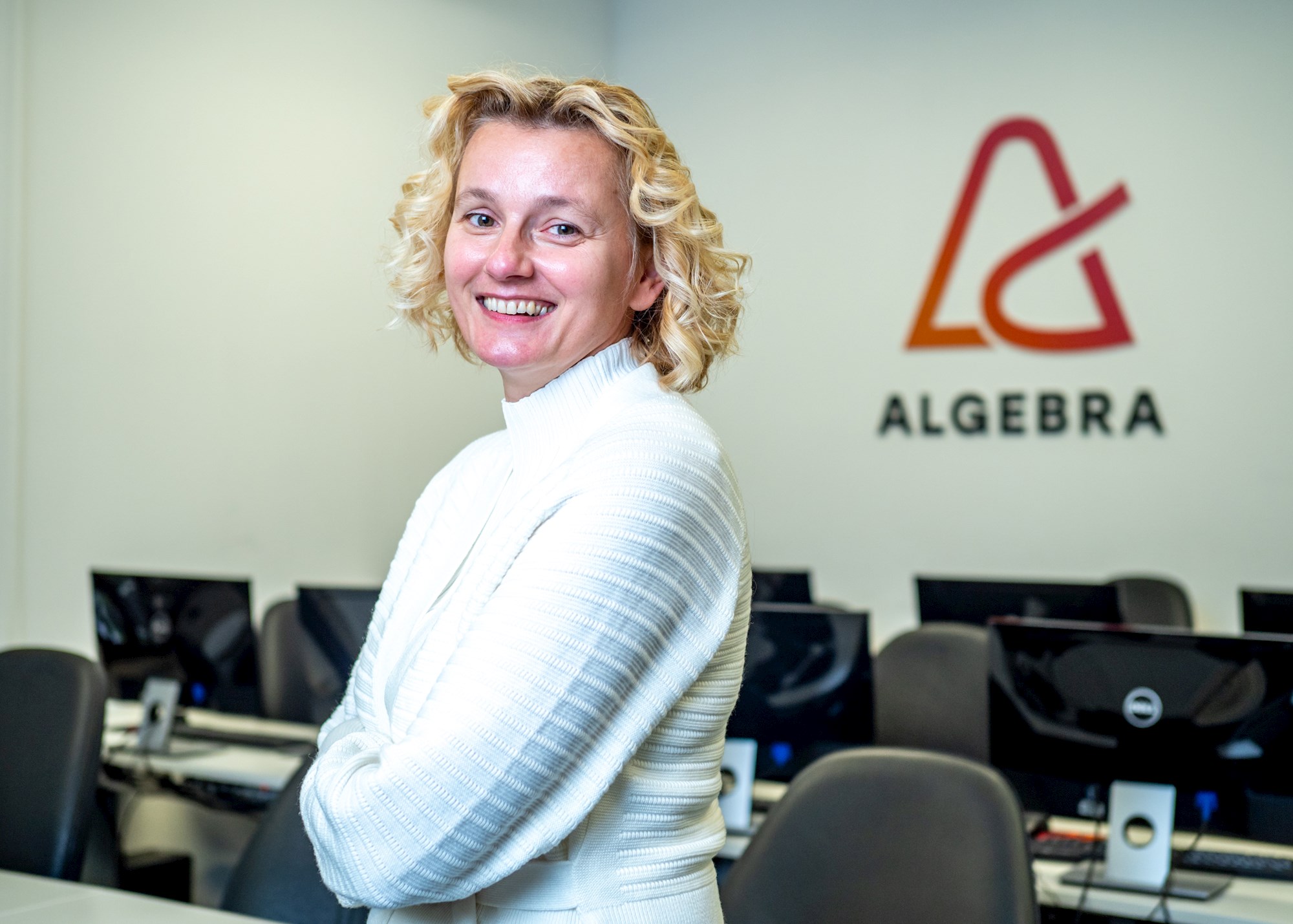
"It is expected and quite logical that the students of this generation decided on this topic because the idea of digital nomads is something that will be very prominent and present in their work experience. Moreover, Algebra students from abroad are also digital nomads, in a way. Currently, we have 2-3 startups in Croatia working on this topic, so it is very hot, and the need for such a platform is real," emphasizes Maja Brkljačić.
Such projects, once launched, can significantly contribute to the country’s success and attractiveness as a destination for digital nomads. These people travel efficiently and quickly, change their geographical location, and just as easily and quickly need to get the critical information. The project is set up in a scalable way. It can be easily replicated to other countries, which is crucial for finding sources of funding because VC funds and EU funds strongly prefer global or at least European solutions.
"From this group interdisciplinary project, I learned a lot about the marketing side of development and product design itself. I also received knowledge from colleagues in the field of data science about the use and management of information and how to implement it in our product," says Andro Žonja, a programmer who develops the back-end, i.e., the server-side of the application, which consists of a layer with business logic and a database and enables communication internally and with the client part of the application.
On the other hand, one of the future graduates of data science, Mateja Novaković, also says that "interdisciplinary cooperation is quite common today and is encouraged in all spheres of life and work." She liked working with fellow program engineering students because it allowed her to go beyond the tasks she has as a member of the data science team.
"I think this is one of the more important subjects because it prepares us for a real labor market where at some point we will need to work with people from different industries and different ways of thinking. So it is exciting for me to work on the project because of all the knowledge that I will get, not only from the mentors we work with but also from colleagues in the team," emphasizes Nina Tudor.
Antonio Akrapović says that just like any other team working on a project, without a reasonable exchange of knowledge and skills, "the project could not even start, so this synergy and exchange of opinions is crucial." Antonio was in charge of the data collection strategy and its application from data science to improve the user experience when searching for the desired service most efficiently.
But just like in the real world, not everything is always ideal - and one learns through challenges. Ivan Jakovljević especially emphasizes good communication as a prerequisite for integration and the success of each team:
"The fact that members come from different educational backgrounds enriches ideas and views on the problem, but also sometimes makes communication difficult. As a result, each newly formed team has a relatively low level of efficiency given the potential of its members. Over time, the team adopts a common language manifested in norms and a clearly defined work process. Only after that step can the team realize its potential. However, to get to that point requires quality communication and overcoming certain obstacles, which is challenging to learn from books but requires the experience of teamwork.
The mentor's task is to help the team with their knowledge and experience during the two years of project development. Of course, there are always several challenges.
"The biggest challenges arose with project modules that students have not dealt with so far, such as security aspects and the use of certificates, and data collection, which made it difficult to analyze and evaluate such tasks because students did not have reference experience with similar functionalities," says Aleksander Radovan, Algebra lecturer and expert in Java software solution development. But such situations are good because students have the opportunity to acquire knowledge that they have not yet encountered while studying or working on real projects.
Aleksander Radovan advised a team of students in the segment of software engineering and the use of current technologies in developing solutions.
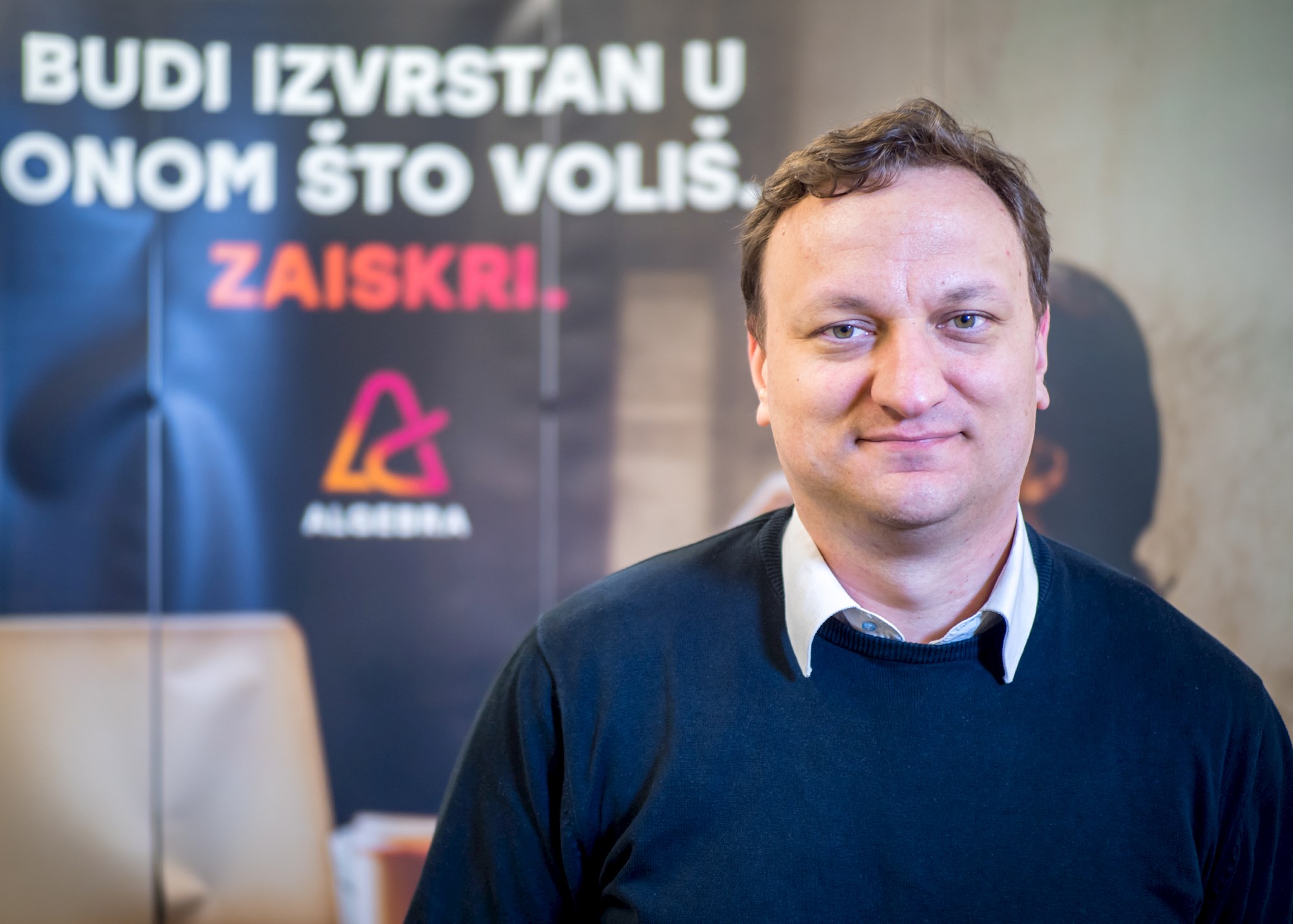
"In such situations, we helped students by adding a task related to research and development - R&D - and, after discovering how they can implement certain functionality that was a challenge for them, in the next project sprint, i.e., intensive work with a mentor, I can add the job of creating specific functionality," explains Radovan.
It is crucial, just like with any other startup, that students avoid pitfalls when developing projects.
"Most startups are designed in a way that their founders start from their own needs, believing that if the product is helpful to them, then it will probably be beneficial to others. However, such an assumption needs to be verified or validated by market research, which is a rather complicated procedure.
Our biggest challenge was to check if our ideas seem helpful to other people and try to rank them according to market interest," says Ivan Jakovljević.
Finally, how to successfully launch a new web application with such international solid competition arises. Maja Brkljačić, Business Development Manager at Algebra LAB and who has extensive experience in mentoring and organizing the incubation process for many startups, can offer advice not only to this innovative team but also to others working on similar projects in their startups.
“First and foremost, I would say: know your customer. The market for mobile applications, but also web applications, is a shark pool. In October this year alone, 69,000 new mobile appointments were announced on the Google Play Store. So for someone to want to install your application on their mobile phone or use your web service, they must be motivated," emphasizes Maja Brkljačić.
Then "you need to know how to reach that user; how they can find you among more than half a million new applications a year."
"I would say that the communication process must be as fast and simple as possible - the digital age does not suffer delays, technical problems, waiting. Which means your app needs to work perfectly. In other words - it is better to have a smaller number of functionalities when entering the market, but the degree of their refinement is as high as possible," she concludes.
Ultimately, the "Nomad Rescue" team gains valuable and vital experience and knowledge of how developing such a project in practice looks. Although this knowledge is, for the most part, actually an extension of what has already been learned during their studies, they emphasize that it is always necessary to acquire knowledge outside the formal educational process.
"It is necessary to acquire knowledge independently and outside the framework prescribed by the study curriculum. However, the knowledge we gained from different subjects proved extremely useful in certain application development steps. For example, in the field of software engineering, these are topics such as how to organize large amounts of data to be easily accessible for analysis, how to containerize an application to run on multiple computers, cryptography for sensitive data protection, and other technical topics that are crucial for the success of our project," sums up Ivan Jakovljević.
This course teaches students to neglect their domain specializations in one section and look for a common language with other colleagues.
“We ask them to participate, as much as possible, together in working on different tasks: so software developers have to start communicating with end-users, which is a very new and often surprising experience for them. At the same time, product developers develop a functional specification and face, for example, how difficult it is to make changes to functionalities once they have been developed. So tomorrow, when they will work on similar complex projects, we expect that our students will communicate much better and understand their colleagues in other departments," concludes Maja Brkljačić.
To read more about lifestyle in Croatia, follow TCN's dedicated page.
Trokut Šibenik Incubator Reflects on Successful Summer with Digital Nomads
September 17, 2021 - Trokut Šibenik incubator reflects on the success of its new digital nomads' office and winning at the European Enterprise Promotion Awards 2021.
The Trokut Digital Nomads office officially opened back in May 2021, following the announcement of digital nomad visas in Croatia as of January 1, 2021, allowing a temporary stay in Croatia for up to one year. Digital nomads can also apply for a second, subsequent digital nomad visa, but only 6 months after the first visa expires.
"We follow the story that is developing at Trokut with joy and optimism. We are glad that Trokut has already become recognized as a place that brings together young entrepreneurs from Croatia and the world. Entrepreneurs of the new generation who lead us into the future can find their opportunity here. We believe that all digital nomads who visit Šibenik once will fall in love with this city and all the advantages it provides," said Šibenik Mayor Željko Burić back in May.
Digital nomads do not have fixed working hours or jobs because they work as needed depending on what is currently on their plate. Some nomads work more than 12 hours a day, but their place of work often changes. In addition, the coronavirus pandemic has increased the number of remote workers, making the term "digital nomads" more popular than ever before.
“Based on thinking about digital nomads who most often like to work in coworking spaces, we developed the concept of the Trokut Center, which is adapted to them because they fill a large part of that space. We have predicted well, evidenced by the need for new office desks in the first year of operation. I believe that the occupancy of digital nomads at Trokut will be more than satisfactory," added Petar Mišura.
And this summer confirmed just that.
Namely, this summer, Trokut was visited by over 40 digital nomads, mostly foreigners, while their average stay in Trokut and in Šibenik was 18 days. While some were passing through, others chose Šibenik as their destination for longer holidays. Digital nomads have highlighted the beauties of Šibenik-Knin County, beaches, fortresses, and Krka National Park, in combination with Trokut, as a perfect combination for business.
Children's STEM camps have also been completed. Trokut reported that they are very proud of "their Trokutići" because, under the watchful eye of teacher Ivan, they programmed everything themselves, designed it in 3D, and held a robotics competition. They would also like to thank the US Embassy in Zagreb for providing them with the necessary equipment to hold these workshops and go through all the important elements of STEM. Ivan Šoda confirms and adds:
"The children have mastered a diverse program, and I am sure that this camp has aroused their curiosity in the field of IT."
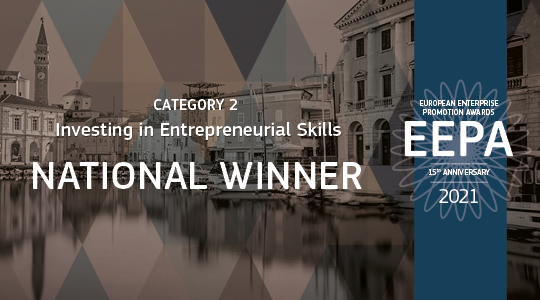
More great news from a successful season is that Trokut won first in the “Investing in Entrepreneurial Skills” category at the European Enterprise Promotion Awards 2021. The award was won for holding Incubator 2021, the first of its kind in the Šibenik-Knin County area, whose target group was small and medium-sized enterprises focused on being successful and competitive in the domestic and foreign markets.
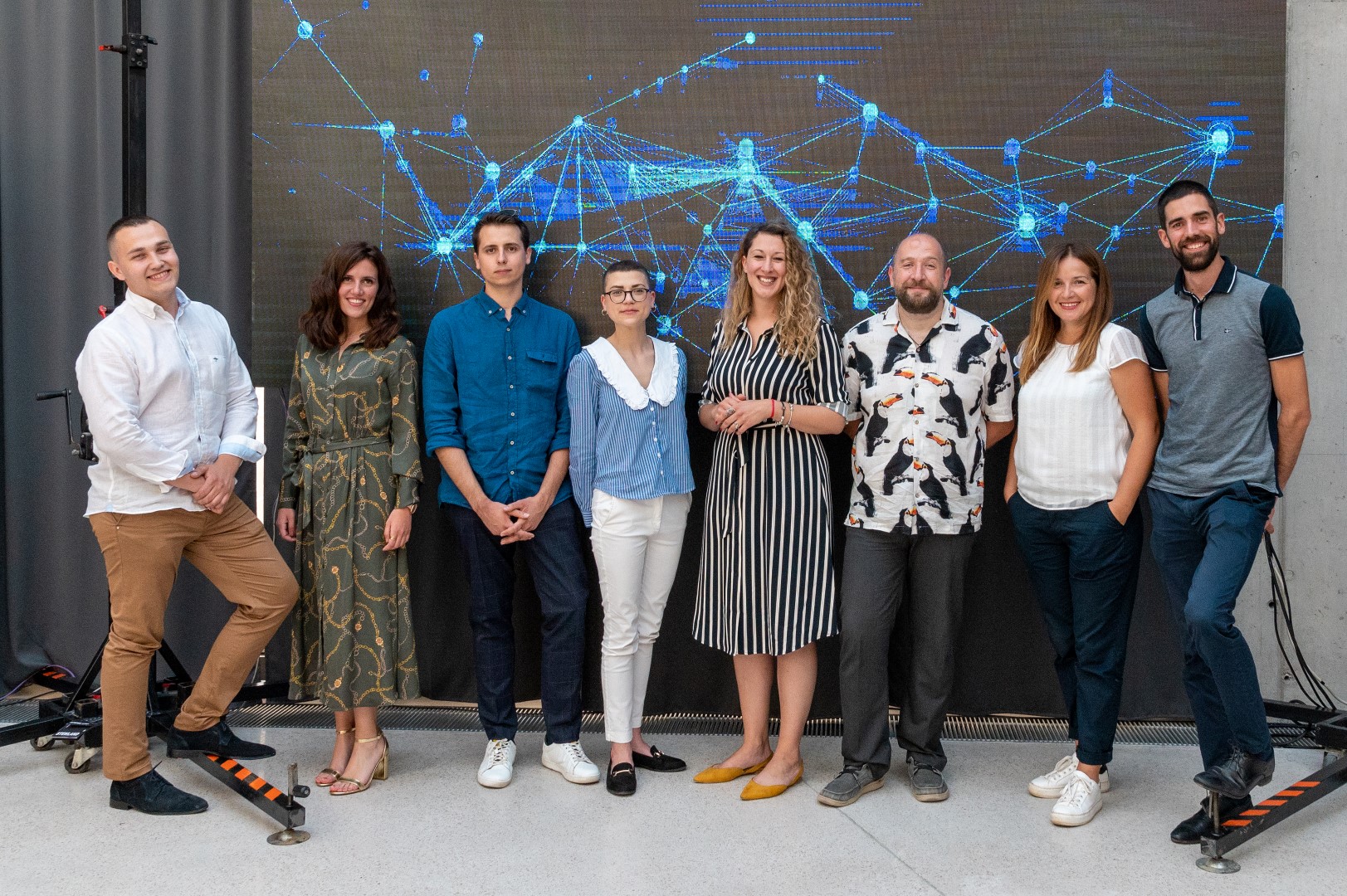
“Winning this award is a confirmation of our work and a confirmation of the long-term strategy of the City of Šibenik. We are glad to see that entrepreneurs primarily accepted us and have really become a recognized Center for Entrepreneurship, Innovation, and Education. This award is an additional motivation to continue our work and contribute as much as possible to the entrepreneurial community," concluded director Diana Mudrinić.
You can learn more about Trokut HERE.
For more on digital nomads in Croatia, follow TCN's dedicated page.
Digital Nomads Promote Croatian Tourism Best, Says Minister Nikolina Brnjac
September 3, 2021 - Minister of Tourism and Sports said that digital nomads promote Croatian tourism best, on the same level as social media influencers.
According to the tourist traffic data for July and August compared to pre-pandemic figures, Croatia is the tourism star of the Mediterranean this year.
In August, 86 percent of arrivals and 93 percent of overnight stays compared to 2019 were realized. Specifically, about 4.3 million guests visited Croatia last month, and over 30 million overnight stays were realized. Thus, after the lost pre-season, the main season has restored optimism among tourism workers who will have a good post-season if the epidemiological situation allows. However, in addition to all other factors and the situation in the Mediterranean, Croatia has really prepared well for the season, primarily by ensuring the safety of guests, with a great response from foreign partners and the Ministry of Tourism and Sports' Safe Stay in Croatia campaign. Furthermore, the framework for digital nomads was defined at the beginning of the year. In addition, several other activities contributed to the season, which really surprised even the most optimistic.
Before today's press conference, Novi List spoke with Minister Nikolina Brnjac about what August was like, what was crucial in preparing for the season, how staff shortages will be solved, and the prospect of digital nomads in Croatia.
August is behind us; many say that even the most optimistic could not expect such results in July and August. Was it more than expected?
"I think we have prepared well for this season, in cooperation with the entire tourism sector, in coordination with the Civil Protection Headquarters and all other closely related stakeholders. The fruit of all this synergy is this season's tourist results. Already on August 29, we achieved our minimum goal for traffic for this tourist year, which is 60 percent of tourist traffic compared to the whole of 2019. Still, we believe that the continuation of current favorable trends will be much closer to that record year by the end of the year. In the last days of August, we recorded traffic above 90 percent of what we had in 2019, which is a great announcement for September and for the postseason in general, which is our next goal. Compared to 2019, the biggest difference is in arrivals, but the number of overnight stays shows that tourists stayed longer and spent more.
I believe that we can all be satisfied with the results achieved when we talk about tourist traffic and when we talk about revenue, but now we want to extend the season as much as possible. With all our activities, the epidemiological situation was critical throughout the summer. It will continue to be so, and I believe that we will continue to behave responsibly, get vaccinated in as many numbers as possible because only in this way can we maintain continuity of good results, and ensure normal social and economic trends."
What was crucial in the preparation of the season and ultimately its realization?
"I think that the key thing was that with the preparations for this year's summer tourist season, we started on time with the synergy of the entire tourism sector and all departments in the Government. In each step we took, we involved the sector, listened to their needs and the market's needs, and thus made decisions about each step.
Starting with the Safe Stay in Croatia project, which was well-received in our biggest markets and which provided tourists with access to all relevant information in one place, and at the same time was a tool for educating our tourism sector on procedures for compliance with epidemiological protocols, then facilitating travel procedures and returning tourists to their home destinations by providing additional testing points, to enabling tourists to be vaccinated in Croatia. Since the beginning of the pandemic, we have been paying great attention to good communication and education of everyone in the system to have timely information and better adapt to today's trends and business conditions. Before and during the summer, we continuously held meetings with tourism stakeholders, leaders of local and regional governments, epidemiologists, and civil protection headquarters in their area so that everyone could be better prepared. As a result, tourism workers were also among the first to be vaccinated in a high percentage. All this shows how much we were all aware of the safety aspect and preparedness as an important factor in the choice of destinations by tourists. As a result, Croatian tourism has once again shown exceptional readiness and all the diversity of the offer that can satisfy the demand of different guest structures. I sincerely thank everyone for the cooperation, effort, and knowledge they have invested so that we can have such good results in another challenging year for tourism."
Which markets were the best in August and the first eight months of 2021? What has changed compared to last year and the years before the pandemic, and what does that tell us?
"The pandemic has definitely affected the travel paradigm, i.e., the habits of tourists for whom safety is one of the most important factors when choosing a destination. We are all aware of that, and that is why we have been working from the beginning to improve all security measures to create the most favorable preconditions for tourism. In addition to the demand for high-class accommodation facilities and those in nature, we also record excellent results in the charter segment. We achieved an even higher turnover in August compared to August 2019. When we talk about changing the structure of guests, the share of guests from nearby markets has further increased. In contrast, for more distant markets, stabilization will occur subsequently, depending on the normalization of travel and the favorable epidemiological situation in the world."
Which segments of the offer proved to be the most sought after? Namely, there is a lot of talk about the fact that 5-star, therefore the highest quality offer was the most sought after?
"Through this year's financial results and the fact that we have the highest occupancy in high-end accommodation facilities, i.e., four and five stars where we record occupancy above 95 percent, it is clear that this year we have a larger number of tourists with higher purchasing power. Quality products and an offer that gives them an extra sense of security were among the most sought after."
In that sense, can it be said that there has been a kind of transformation towards better quality tourism and moving away from the masses?
"Our strategic goal is to move away from the masses and turn towards sustainable and innovative tourism, and the demand for high-quality products and a longer stay in the destination certainly goes in favor of that. In the long run, our goal is to increase the number of tourists compared to previous records, especially in already congested destinations, and distribute tourist results more evenly throughout the year and throughout Croatia while achieving equal or higher total revenues. By the way, even before the pandemic, we started to reform the legal framework aimed at the sustainability and professionalization of tourist boards, recategorize private accommodation, regulate the status of health tourism, tourist land, and the like. We will continue with reforms that will follow our strategic goals."
The Ministry has also initiated the Sustainable Tourism Development Strategy. Will this document also be the basis for further profiling towards high-quality tourism?
"With the new Sustainable Tourism Development Strategy until 2030, we will focus on sustainability, value-added products, and special forms of tourism. The strategy should respond to the challenges of extending the season and expanding the tourist offer outside the summer months and in spatial terms to less-developed tourist areas, especially continental destinations. The project of drafting a new strategy is in line with the Program of the Croatian Government from 2020-2024 and the National Development Strategy until 2030. For the first time since Croatia's independence, the Sustainable Tourism Strategy, a Strategic Environmental Assessment, is being prepared. The fact that we have been provided European funds with which we can strategically direct tourism development should be emphasized. Simply put, we have provided the opportunity to invest in the tourism we want, and that is sustainable, year-round, with greater added value. Funds from the National Recovery and Resilience Plan will focus on solving the challenges we face in the coastal zone in the summer and encourage the development of year-round forms of tourism with high added value throughout Croatia. The fact that in the next financial period of the EU, both in the National Plan and in certain operational programs, we will be responsible for allocating funds is a great obligation, but also an opportunity to define priorities together with the sector and try to solve long-standing challenges."
In preparation for the season, a big step forward was made towards attracting digital nomads at the beginning of the year. So what specifically has changed legally?
"Croatia is one of the first members of the European Union to legally regulate a one-year temporary stay for digital nomads from third countries. This is an interesting niche for Croatian tourism because nomads are not seasonal but year-round guests, and their interests are diverse and unrelated to the sea and the sun. The idea was realized with excellent inter-ministerial cooperation with other ministries, primarily with the Ministry of the Interior, which carried out the most important legislative processes and the Ministry of Foreign and European Affairs. The Ministry of the Interior amended the Law on Foreigners, and the Ministry of Foreign and European Affairs announced the procedure for obtaining temporary residence for digital nomads. At the same time, the Ministry of Finance changed its laws through its Income Tax Act and the Ministry of Health through the Law on Amendments to the Law on Income compulsory health insurance and health care of foreigners in Croatia, all to enable the stay of digital nomads in Croatia. Furthermore, the Ministry of Tourism and Sports has initiated an e-platform for digital nomads, with the help of the Croatian National Tourist Board, and we have included 21 regional tourist boards in all processes so that digital nomads have the opportunity to discover the whole of Croatia."
What are the conditions for the arrival of digital nomads, and do you have information on how many have taken advantage of this opportunity?
"Digital nomads must first meet all the prescribed conditions to obtain a temporary one-year stay in Croatia. All steps are described in detail on the Ministry of Interior website. By August 20, more than 200 people had applied, while about 80 had been approved, with the most applications coming from the US, UK, and Russia. However, persons working in Croatia as digital nomads, i.e., for companies not registered in Croatia and citizens of EU member states, do not regulate their stay on the same legal basis and are not recorded based on the relevant new provision of the Law on Foreigners. It should also be noted that our legislative framework has been in force since the beginning of this year, when strict measures to restrict movement were applied. Nevertheless, we expect that the improvement of the epidemiological situation and further activities that the tourist boards and private sector plan to initiate will have a positive impact on the interest of digital nomads in Croatia."
Have accommodation providers prepared and generally realized the benefits of longer leases, which we specifically offer to digital nomads?
"Digital nomads, with the conditions and steps they must meet to obtain a visa for "digital nomads," mostly search for the content available in certain destinations. The data from our research thus show that tourist products such as active holidays, nature, culture, and eno-gastronomy arouse the most interest, which Croatia offers them. Moreover, many hotel chains have already adapted their tourist offer to the longer stay of digital nomads with the possibility of work."
What do digital nomads, influencers, and world stars really mean for the promotion of Croatian tourism?
"People who want to make Croatia their temporary office, who fall in love with our natural and cultural beauties, food, people, but also the way of life, can be our best promoters, just like many influencers. Any positive reaction to Croatia as a tourist destination, especially in the world that is mostly informed through social networks, is a great advertisement for our country and an additional invitation to stay."
What are the announcements for the offseason?
"The announcements for September and October are excellent, judging by the bookings of our hoteliers and camps. As I mentioned at the beginning, in recent days, we have recorded traffic above 90 percent of what we had in 2019, and this is a good announcement for September. If the current trends continue in the next month, in the second half of September, we could reach 70 percent of turnover when it comes to overnight stays and financial indicators."
One of the basic problems of Croatian tourism at the moment is staffing. How will efforts be made to address the shortage of tourism workers that has escalated this year, and what is the future?
"In the long run, we see solving the problem of labor shortage in the creation of preconditions for the engagement of domestic labor in the tourism sector. For several years now, the Ministry of Tourism and Sports has been implementing measures to promote tourism occupations through the co-financing of innovative tourism projects designed and implemented by high schools to educate students in hospitality and tourism. We also have a program for co-financing the practice of high school students in the tourism sector. Through the National Recovery and Resilience Plan, we have provided an additional 10 million kuna to develop educational programs that meet the needs of the labor market. We will also allocate funds for training with employers to support investments in the green and digital transition. We want to increase the attractiveness of tourism occupations for young people and improve conditions and general satisfaction of workers in the tourism sector. We are actively thinking about how to ensure a sufficient quality workforce, first from Croatia, and then through imports, because the quality of services is an indispensable part of the tourist product."
To learn more about digital nomads in Croatia, follow TCN's dedicated page.
Croatia Through the Eyes of a Digital Nomad: Yachting Part 2 - Yacht Week Host
July 8, 2021 - Digital nomad Cyndie Burkhardt reveals what life is like as a Yacht Week host for a week.
Some experiences are too good to pass up and whether you have fun or live to regret it, you go along for the ride just for the kick of saying you did it.
When something falls out of left field and I know I just have to say “yes,” I follow my gut. It’s all about the journey, right? Want to be a yacht host for Yacht Week in Croatia? Main responsibilities: prepare, cook, and serve meals for 12 people; manage the galley and the food supply; clean the heads. Below Deck has nothing on this gig…
 Everyone comes together in the galley—it’s the workspace for hosts and the café for guests. All photos ©2021, Cyndie Burkhardt.
Everyone comes together in the galley—it’s the workspace for hosts and the café for guests. All photos ©2021, Cyndie Burkhardt.
Port of departure: Trogir
Saturday was the start of Week 23, as The Yacht Week group calls this particular week in its summer sailing season. Fifty boats with ten guests each (plus hosts and skippers) comprise its biggest flotilla of the year. I fell into a job as a yacht host and found myself in an alternate reality from my previous week with Croatia’s elite sport—I went from guest to staff in a single day. My work began at the marina, including provisioning the boat, unloading food and liquor packages, inspecting inventory, and greeting my “crew,” as guests were called.
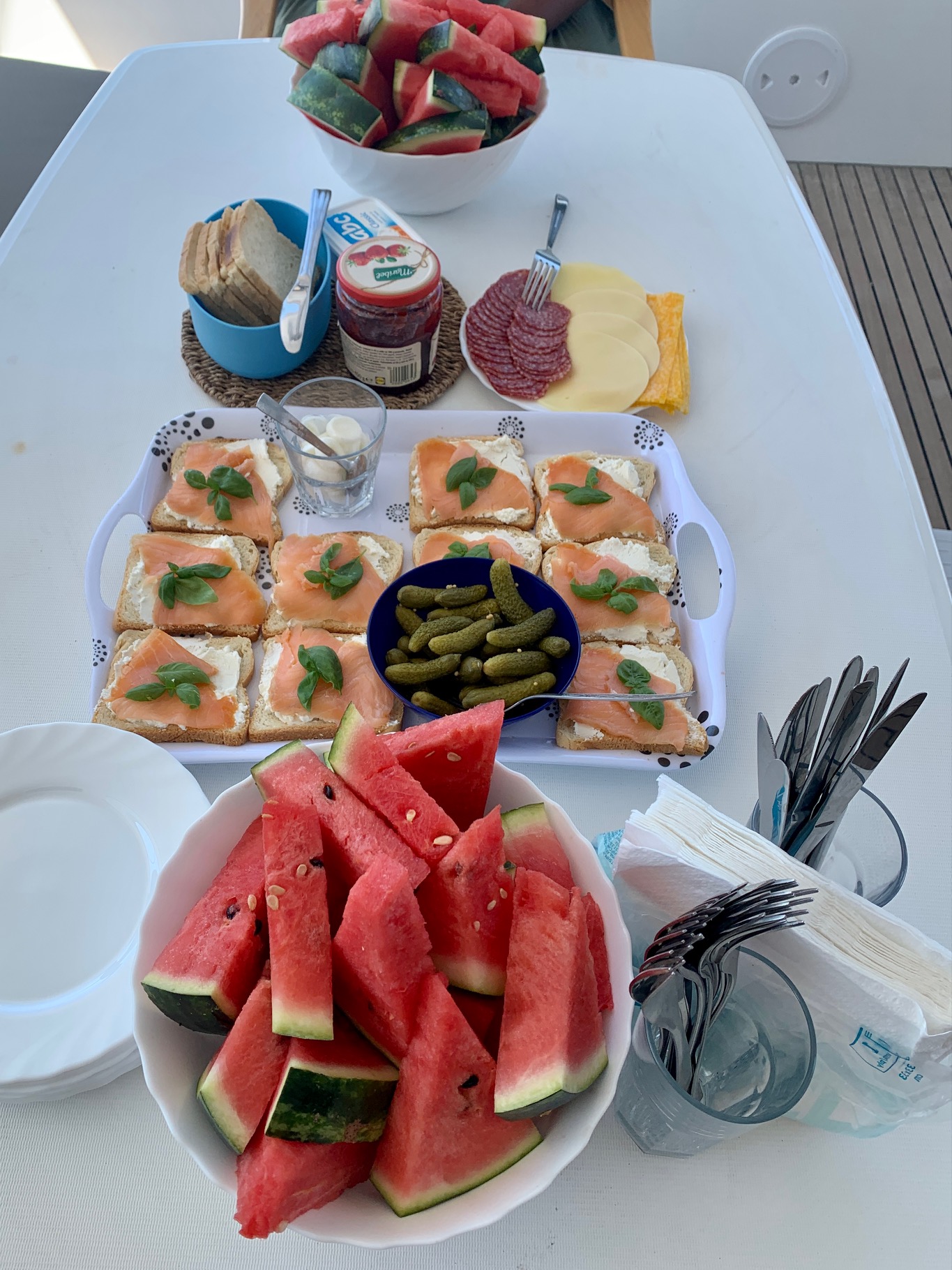 Breakfast. All photos ©2021, Cyndie Burkhardt.
Breakfast. All photos ©2021, Cyndie Burkhardt.
The job
People who apply for these jobs typically pay €1,000 to attend a 3-week training academy. I filled out a brief application, attended a free 1-day training, and received my assignment. The only extra effort on my part was to complete an online food safety course for a required certificate. The pay was laughable given the amount of work but hey, it was change in my pocket and maybe the gig would lead to something else.
At first, I was excited and then I grew anxious. What if the guests didn’t like my food? Or me? What if they were demanding, or obnoxious? I received a set menu with recipes for lunch and dinner but I needed to come up with my own breakfast. Sometimes I make quick egg dishes at home—like scrambled or hardboiled—but the company suggested shakshuka (huh?), frittata, Benedict, fried, poached, pancakes, muffins, and more. I had no clue how to make those from scratch and I started stressing about BREAKFAST!
Destination: Vis
Guests got their drink on first thing in the morning—Karlovačko, tequila shots, Hennessy, champagne, Red Bull, vodka, and more. They were content to party on the boat all day rather than explore the towns or the islands. Why travel all this way from home and never leave the dock? It seemed a waste to miss so much of what Croatia has to offer. But it wasn’t that kind of trip...
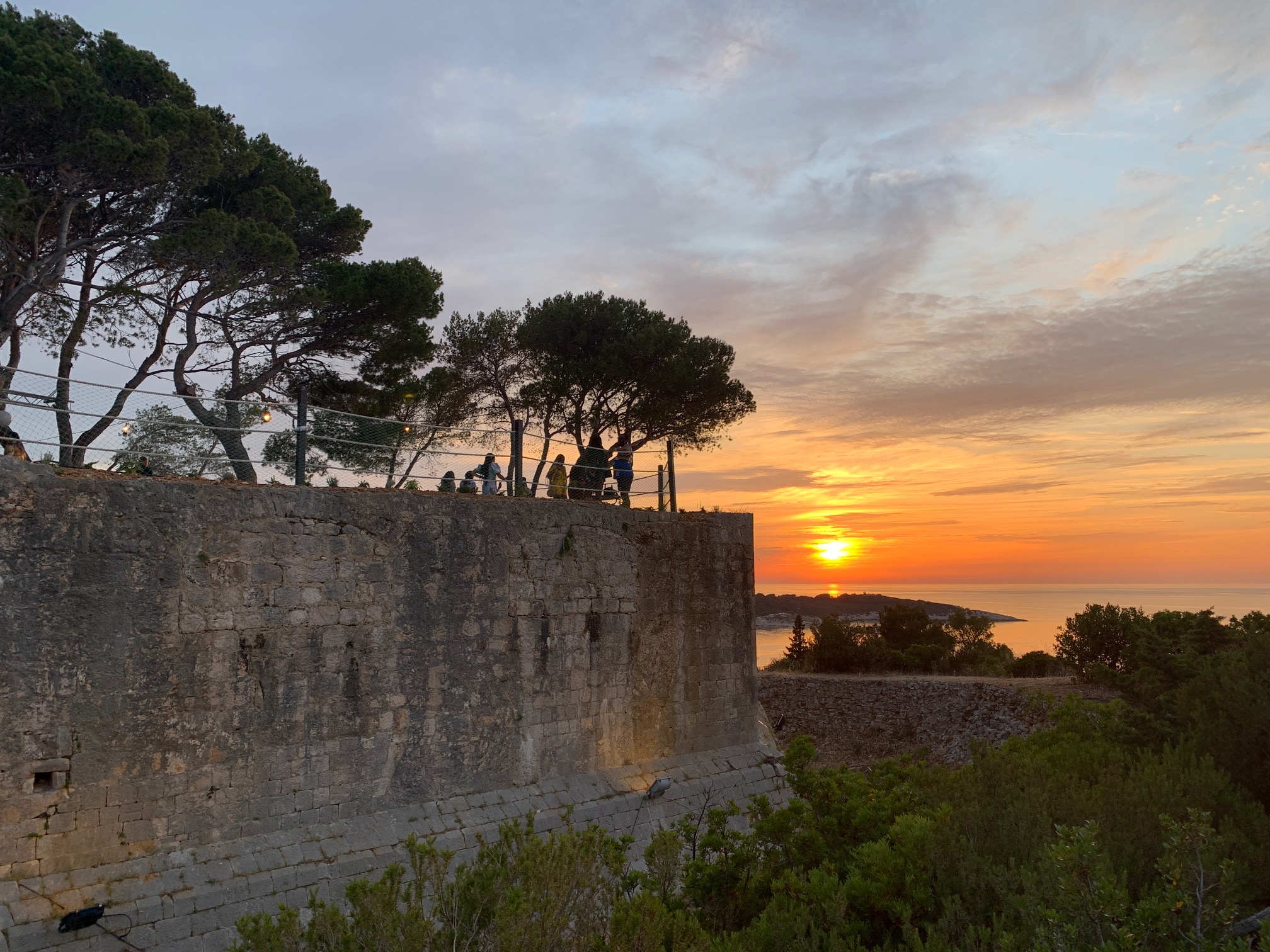 Sunset at Fort George, Vis Island. All photos ©2021, Cyndie Burkhardt.
Sunset at Fort George, Vis Island. All photos ©2021, Cyndie Burkhardt.
When nighttime came however, guests went to a DJ/dance party at Fort George. I’d heard the sunset views were spectacular up there, but today the party was the main event. It felt like I stepped into a music video—crazy DJs, bodies moving in sync with every rhythm and gesture, the crowd singing each word of each song, and all sorts of outrageous clothing—except this wasn’t choreographed.
Destination: Pakleni Islands
The next day started with a circle raft, which was all the boats joining to form a big swimming circle. Guests lounged on their floaties and swigged from their bottles while a DJ boat blared music. By the time we arrived at Palmižana later that afternoon, I was happy to get off the boat for a break and a shower.

The party’s just starting. All photos ©2021, Cyndie Burkhardt.
By 1am I was in the “grave,” sailors’ jargon for my tiny sleeping quarters at the front of the catamaran. To enter, you open a hatch on deck and hop in, there’s no door. When I found out this was going to be my “room,” claustrophobia kicked in and I did everything I could to stay calm. It was still better than sleeping in the galley.
I had just fallen asleep when one of the guests was above my head shouting and pounding on the deck, “Cyndie, are you awake?” Not really, but now I was. One of the other guests wanted to go to the hospital. Oh boy, this wasn’t a drunk prank or a plea to make hangover food. I rallied to get up, wondering what exactly was going on and what to do. Who to contact first, get the medic, get on a boat to the nearest island with a hospital, was it even open at this hour? So many questions were racing through my head…
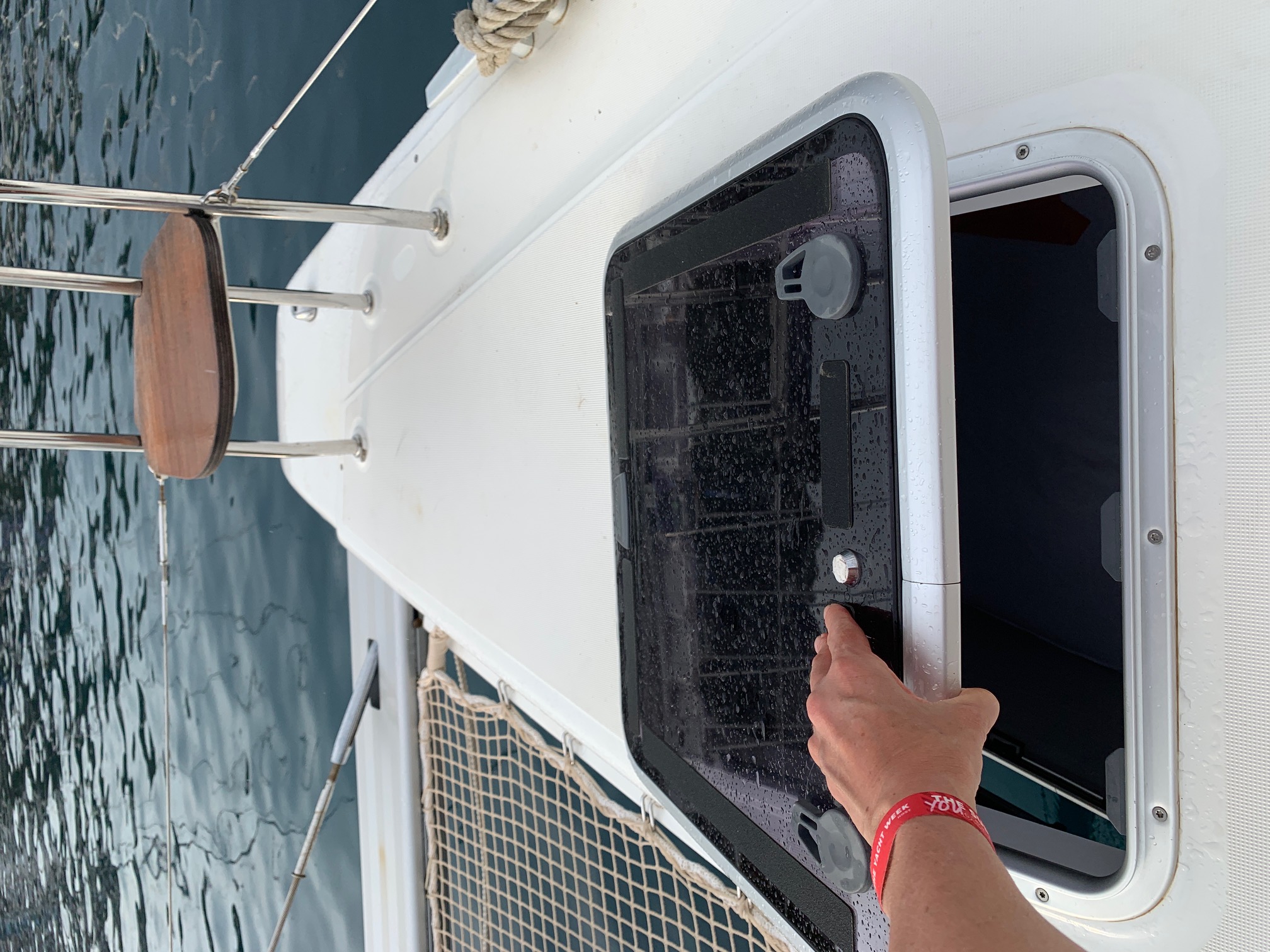
The front hatch on a catamaran leads to the “coffin,” a small sleeping bunk. All photos ©2021, Cyndie Burkhardt.
The girl felt ill and was upset. Me, the skipper, and the guest who woke me jumped into action and helped her calm down; then she just wanted to sleep. She’d been partying hard all day in the hot sun, without drinking water, and it caught up with her.

The “coffin” is named for its size and shape (literally). All photos ©2021, Cyndie Burkhardt.
Destination: Štipanska
The day we hit Štipanska for a barbeque and a party, it was another scene straight out of a music video, only this time I was right in the middle. One of my guests asked if I knew how to twerk. Sure I’ve seen it, but can’t say I knew how to do it. She proceeded to teach me in 10 seconds. Bend over, hands on knees, arch your back, look over your shoulder, shake your butt up and down. Want to take it further? Raise your arm up in the air. It was the most fun I had with my crew and we all shared a good laugh.
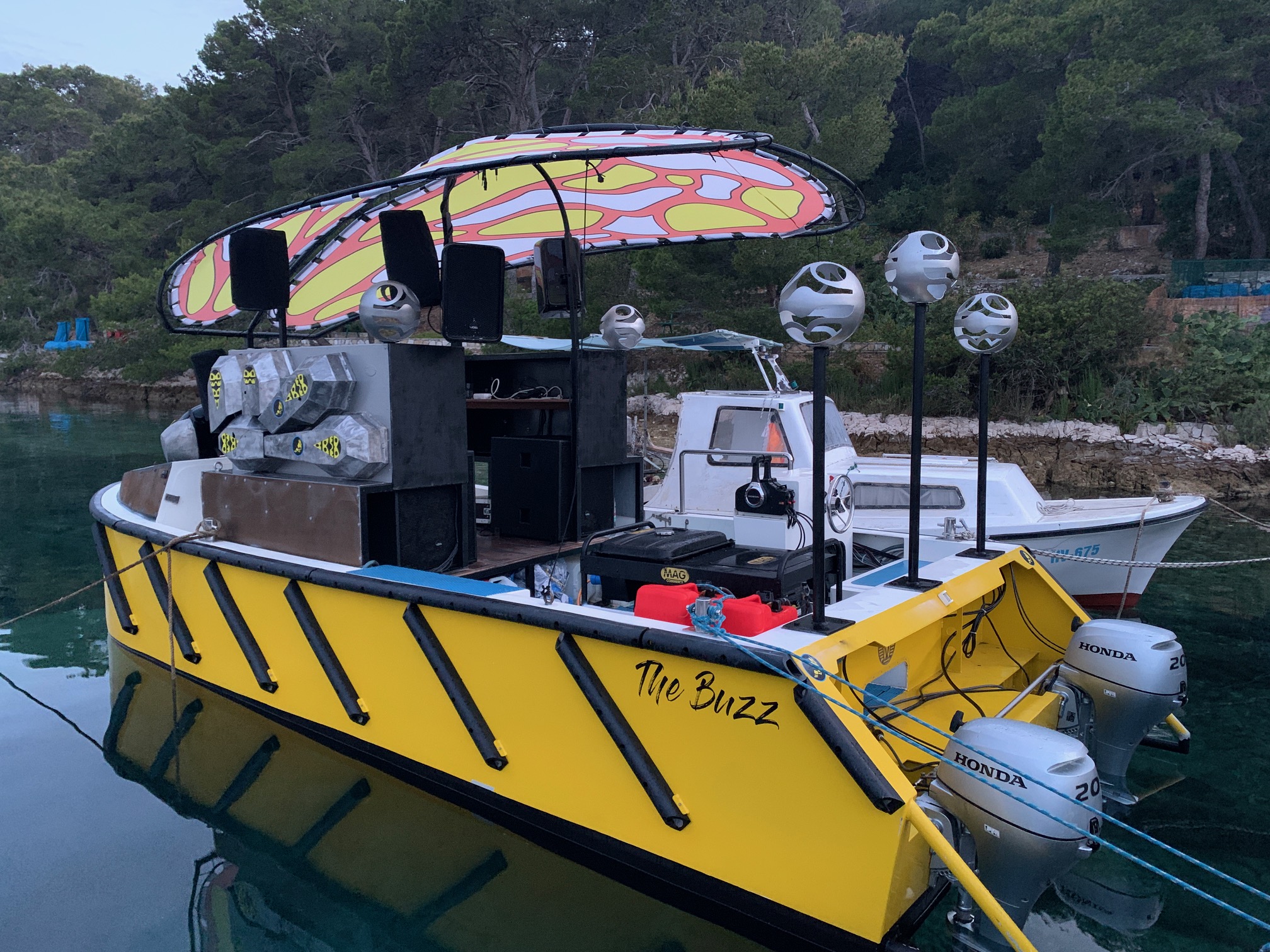 The DJ boat is full-powered with speakers and sound. All photos ©2021, Cyndie Burkhardt.
The DJ boat is full-powered with speakers and sound. All photos ©2021, Cyndie Burkhardt.
Destination: Brač
Midway through the week, this cooking business was exhausting. The job description was clever marketing: prepare food for a few hours a day, enjoy time with your guests, swim, serve lunch, relax and party in the evening. With hours upon hours of prep, cooking, and endless dishes, I had virtually no down time and little sleep. I started to resent the job as it became clear that there would be no “play” time.
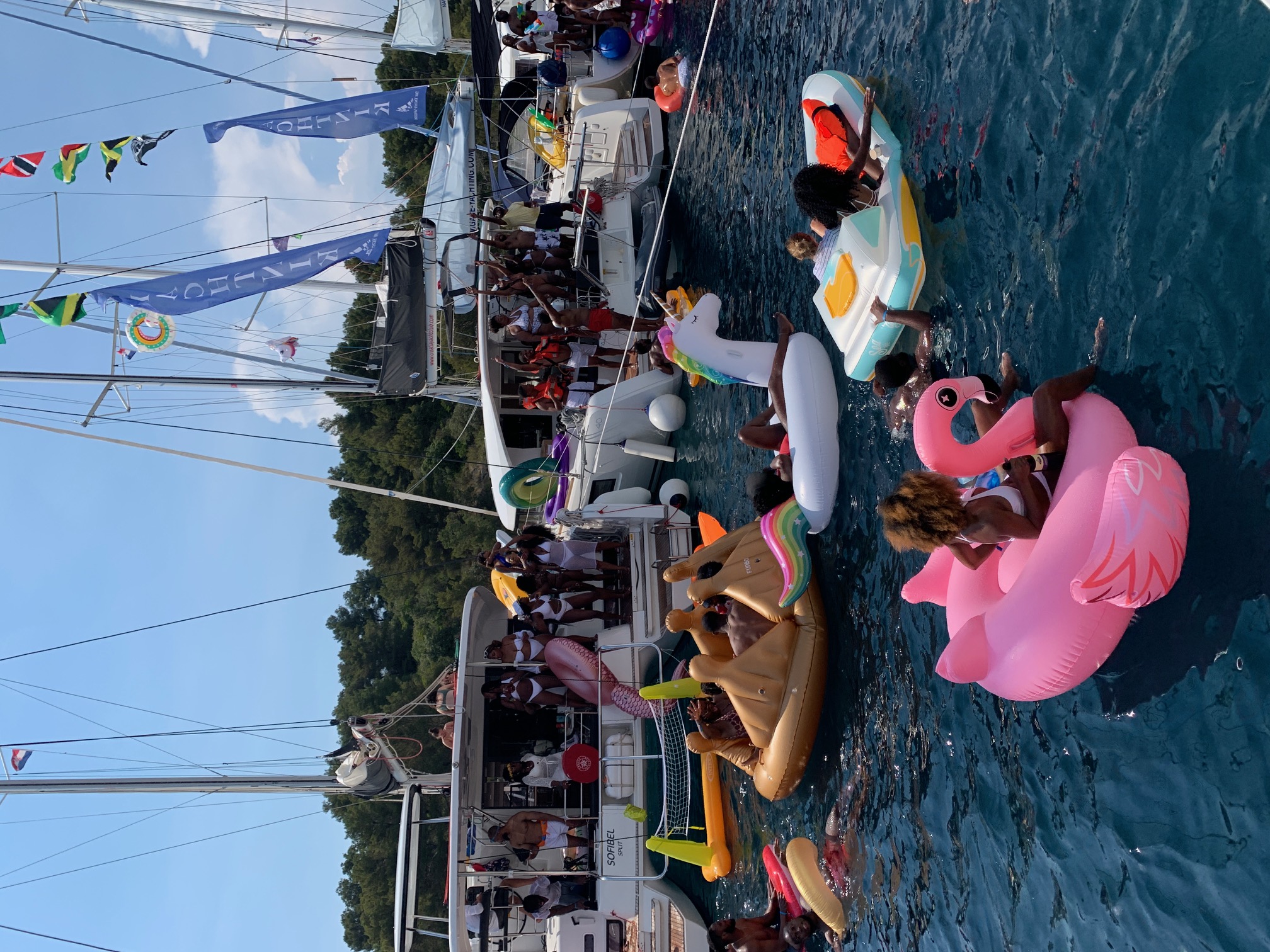
Guests party on floaties and travel between yachts to pick-up friends. All photos ©2021, Cyndie Burkhardt.
At 8pm, the agreed upon dinnertime for this one night, I was ready with salmon, couscous, and tabouleh. The guests were out and started to trickle in after 9pm. It was a chaotic mess and I didn’t finish serving and cleaning up until nearly midnight. I was totally deflated that nobody contacted me about their change of plans or even cared. I crashed in bed, ready for the trip to be over.
Destination: Stari Grad, Hvar
At Stari Grad, we were moored in a bay, with each boat was tied to the next. Guests roamed onboard each other’s yachts to drink and eat while some partied in the water on large floaties. The DJ boat was back and the scene roared on for the entire day and night. I was trapped on the boat to cook, serve, and clean while people got wasted all around me. We never disembarked for the island or saw that side of Hvar.
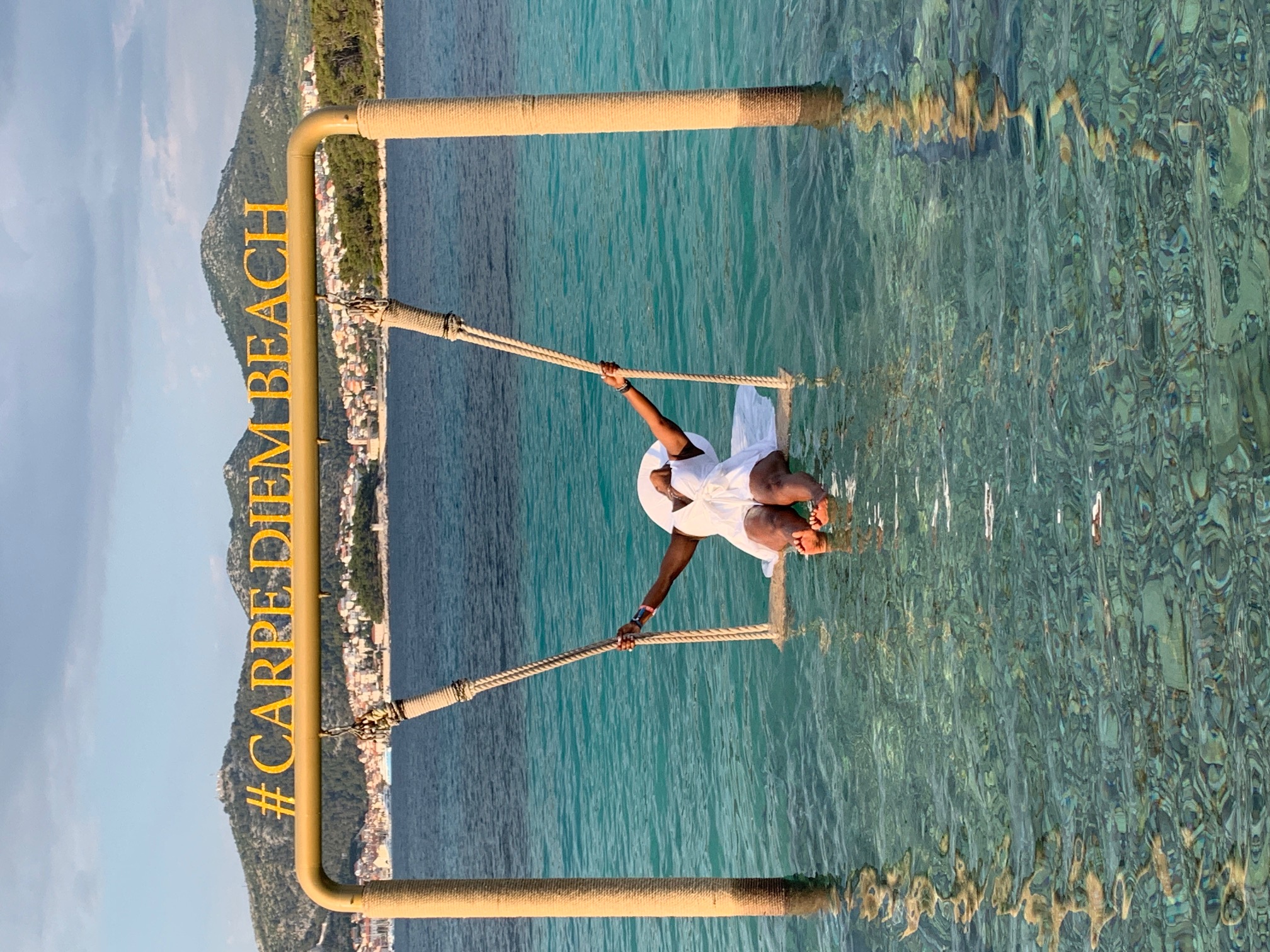 Carpe Diem Beach is a favorite party spot in the Pakleni Islands. All photos ©2021, Cyndie Burkhardt.
Carpe Diem Beach is a favorite party spot in the Pakleni Islands. All photos ©2021, Cyndie Burkhardt.
Destination: Trogir
On the last day, I woke up before 6am and tired as I was, I moved nonstop on all the outstanding duties I needed to complete. I liked my guests and it was a little sad to say goodbye after getting to know them for the week, but I was sooo happy to be going home.
My mother asked if I had fun and I replied, “I’m glad I did it, it was a new adventure. I was off the computer for a week, I lived on a yacht, learned some things, and met some nice people. But no, I did not have fun.” I have a funny story and I’m okay to end it there.
Story and photographs ©2021, Cyndie Burkhardt. https://photo-diaries.com
Learn more at TCN’s Digital Nomads channel.
TCN now has a new resource in the Total Croatia Sailing Page. Get answers and information about Croatia’s favorite pastime on the water.
Croatia Through the Eyes of a Digital Nomad: Yachting Part 1 - The Best Office for Digital Nomads
July 7, 2021 - Why is a sailing yacht the best office for digital nomads? Cyndie Burkhardt tells all.
Many digital nomads enjoy Split’s climate and working with a sea view, which are among the best perks of being here. If beautiful blue water, fresh air, and sunshine are your thing, you can satisfy your inner nature-lover while working ON the sea, with the right yacht and the right skipper.
I grew up by the beach and I love being in, on, and near the water. When friends invited me to join their week-long yachting vacation I didn’t hesitate to say yes. It’s been a goal of mine to experience this beloved Croatian pastime and pre-season was an ideal time of year—not too hot and not too many tourists. We were going to sail around the islands and our sights were set on Vis, Brač, Hvar, and others. Was it warm enough to pack a bathing suit? Check.
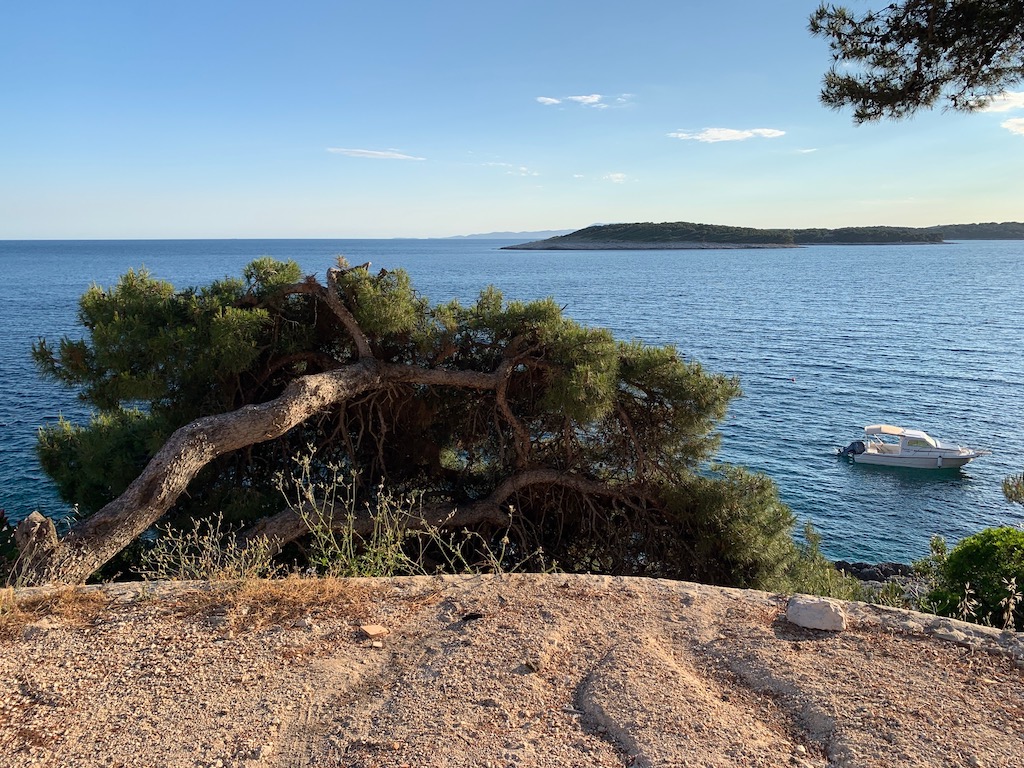 This is why you yield to the Croatian wind, it makes trees literally grow parallel to the earth. All photos ©2021, Cyndie Burkhardt.
This is why you yield to the Croatian wind, it makes trees literally grow parallel to the earth. All photos ©2021, Cyndie Burkhardt.
The ideal remote work
I was a little concerned about getting behind on work because I wanted to relax on the trip without being tethered to a device. I found out there was reliable Wi-Fi onboard and I could login anytime and check my business. Thankfully, that turned out to be true and I never had an issue getting online when I needed to follow-up on a project or check-in for a Zoom meeting. Once I tested the connectivity I relaxed—I’d be able to work and play this week. My vacation wasn’t a digital nomad charter, but it was a good opportunity to see how hard or easy it would be to work when sailing.

Morning view from my cabin, somewhere in the Adriatic Sea. All photos ©2021, Cyndie Burkhardt.
Our yacht was a Lagoon 40 and with the four of us plus the skipper and his wife the space was comfortable enough, although I’ll never get used to cooking in such a compact kitchen. Good thing I have experience with a shoe-box size NYC apartment, it was practically the same thing, although the yacht had much more room to move about than my place back home.
Born on the water
Our skipper, Danijel Razi, was game to hit the islands we mentioned but he hesitated a few times when we asked about the itinerary. Vis today? Maybe later, he replied. I noticed that he kept looking up at this little pointer thing on top of the main sail (a wind vane). He watched the weather and the wind and every nautical detail with his eyes and his instincts, but he didn’t really watch the fancy equipment. His main concern was the viability of the trip and safety. I was curious, what did this guy know and how did he know it?
 An homage to the Beatles and Yellow Submarine; public art on Šolta. All photos ©2021, Cyndie Burkhardt.
An homage to the Beatles and Yellow Submarine; public art on Šolta. All photos ©2021, Cyndie Burkhardt.
It turns out Danijel was born in Viganj, a very windy village on Pelješac that’s a popular sailing destination. Viganj is part of Orebić county, a former maritime center known historically for traditional sailing and navigating, where all the men go out to sea. These guys have lived on the water for centuries before marine electronic systems were invented—working on commercial boats, trading goods, and traveling the world. Danijel comes from a long line of sailors, including his grandfather and earlier generations, and he inherited their skills and their lifestyle. Sailing is in his blood and he clearly loves it.
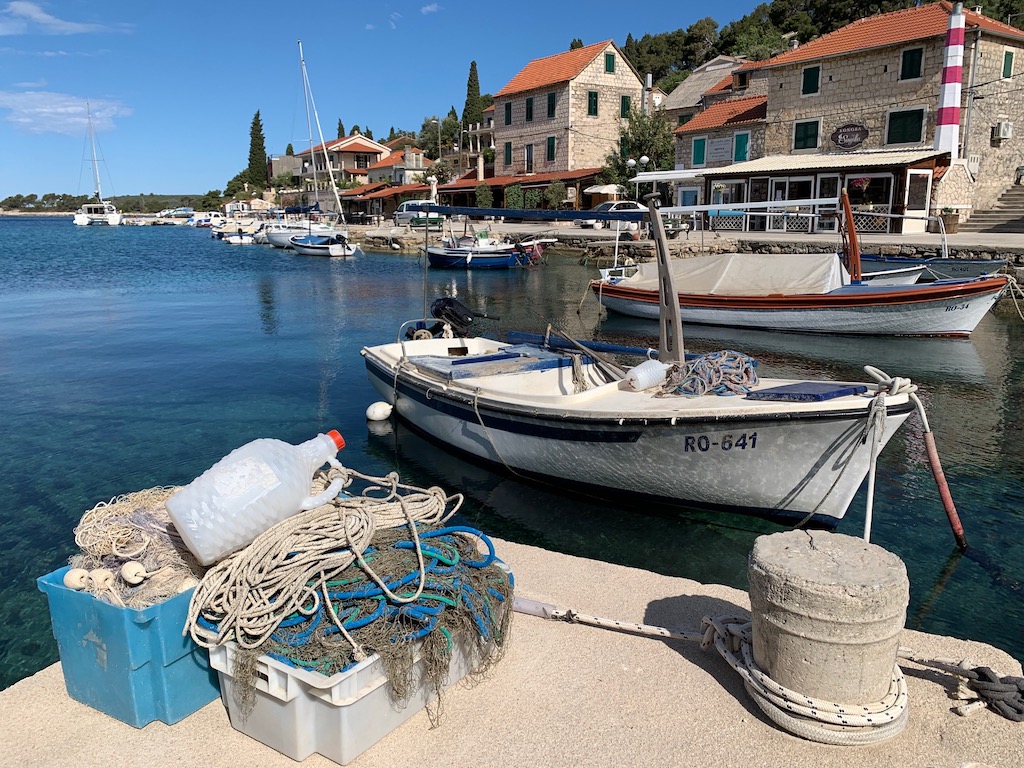 A typical bay and a small village could be any Croatian island; where there’s water there are boats. All photos ©2021, Cyndie Burkhardt.
A typical bay and a small village could be any Croatian island; where there’s water there are boats. All photos ©2021, Cyndie Burkhardt.
Fun fact
Viganj is the second most famous windsurfing location in Croatia, after Bol.
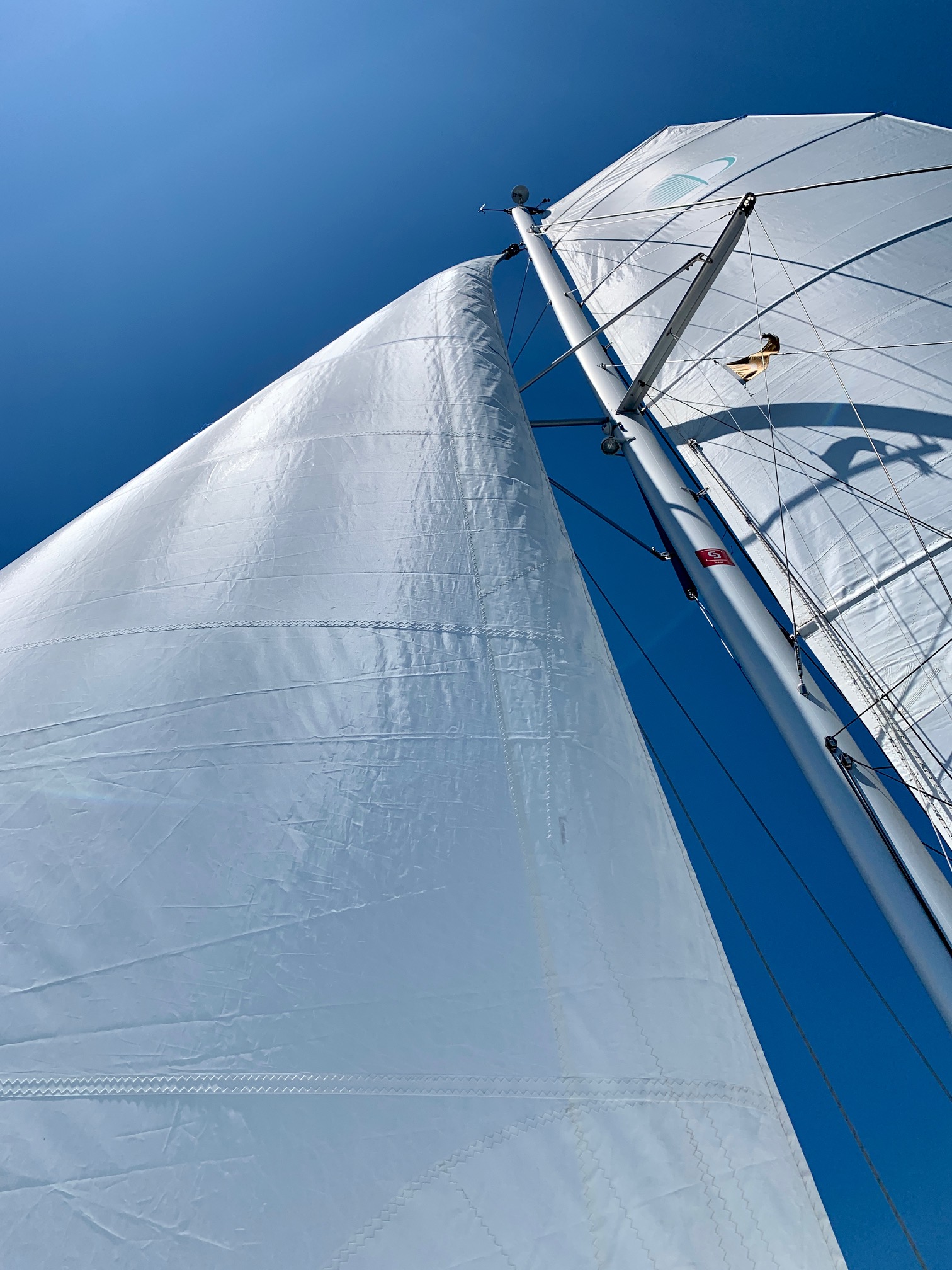 The sound of full sails blowing in the wind and the feeling of gliding across the water makes you want to sit quietly and fully experience it. All photos ©2021, Cyndie Burkhardt.
The sound of full sails blowing in the wind and the feeling of gliding across the water makes you want to sit quietly and fully experience it. All photos ©2021, Cyndie Burkhardt.
Sailing to the island destinations we hoped for, including some bays for swimming, was amazing and there was only one day when the Bura wind adjusted our plans. Skipper Danijel followed nature’s direction and everything worked out. I got in my first swim of the season, which was a tad bit cool but so refreshing.
We’re here and we know
If I do this again, and I hope I do, I learned that a little research can help you get the trip you expect and avoid getting hit with unexpected costs and disappointment.
 Danijel preparing to tie up at a mooring buoy. All photos ©2021, Cyndie Burkhardt.
Danijel preparing to tie up at a mooring buoy. All photos ©2021, Cyndie Burkhardt.
So who are the best skippers and hosts? Without a local presence, charter companies are missing things that people would appreciate knowing. Booking a boat is not like a hotel room—there are lots of details to know about each yacht, itinerary, and destination. Danijel and his crew are based in Croatia. For more info on things you need to check, go here.
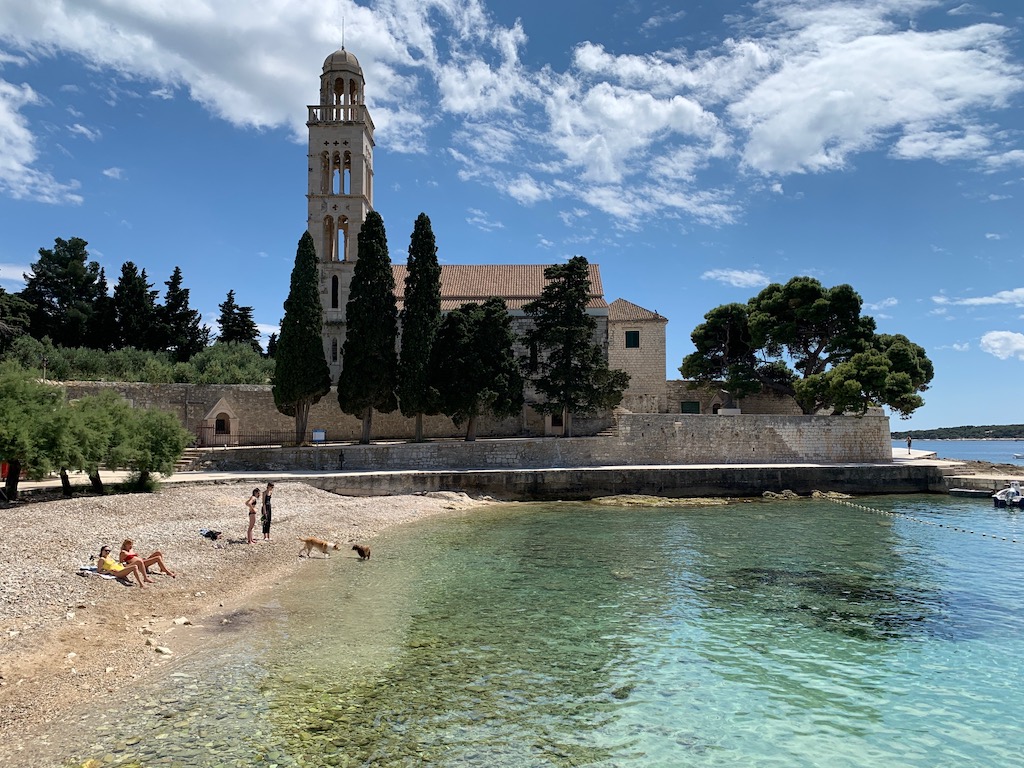 A beach near the Franciscan Monastery and Church of St. Mary of Grace, Hvar. All photos ©2021, Cyndie Burkhardt.
A beach near the Franciscan Monastery and Church of St. Mary of Grace, Hvar. All photos ©2021, Cyndie Burkhardt.
When to go
As far as I’m concerned, any day on the water is a great day. For digital nomads who are in Croatia year-round, I suggest that you consider traveling before and after peak season—April to June and September to November. Prices are lower, destinations are less crowded, you can see the islands better, and service is more attentive with fewer tourists. If you can only go during the summer, just do it!
 A quiet street in Vis. All photos ©2021, Cyndie Burkhardt.
A quiet street in Vis. All photos ©2021, Cyndie Burkhardt.
For thrill-seekers who want something a little different, regattas in Croatia are underrated. It’s possible to join one just to sit on a boat as a counterbalance when a team needs extra weight. How cool is that? Danijel collaborates with some of the teams and I’m already on his list to be notified when my bum is needed, haha. You can be too, contact him by This email address is being protected from spambots. You need JavaScript enabled to view it..
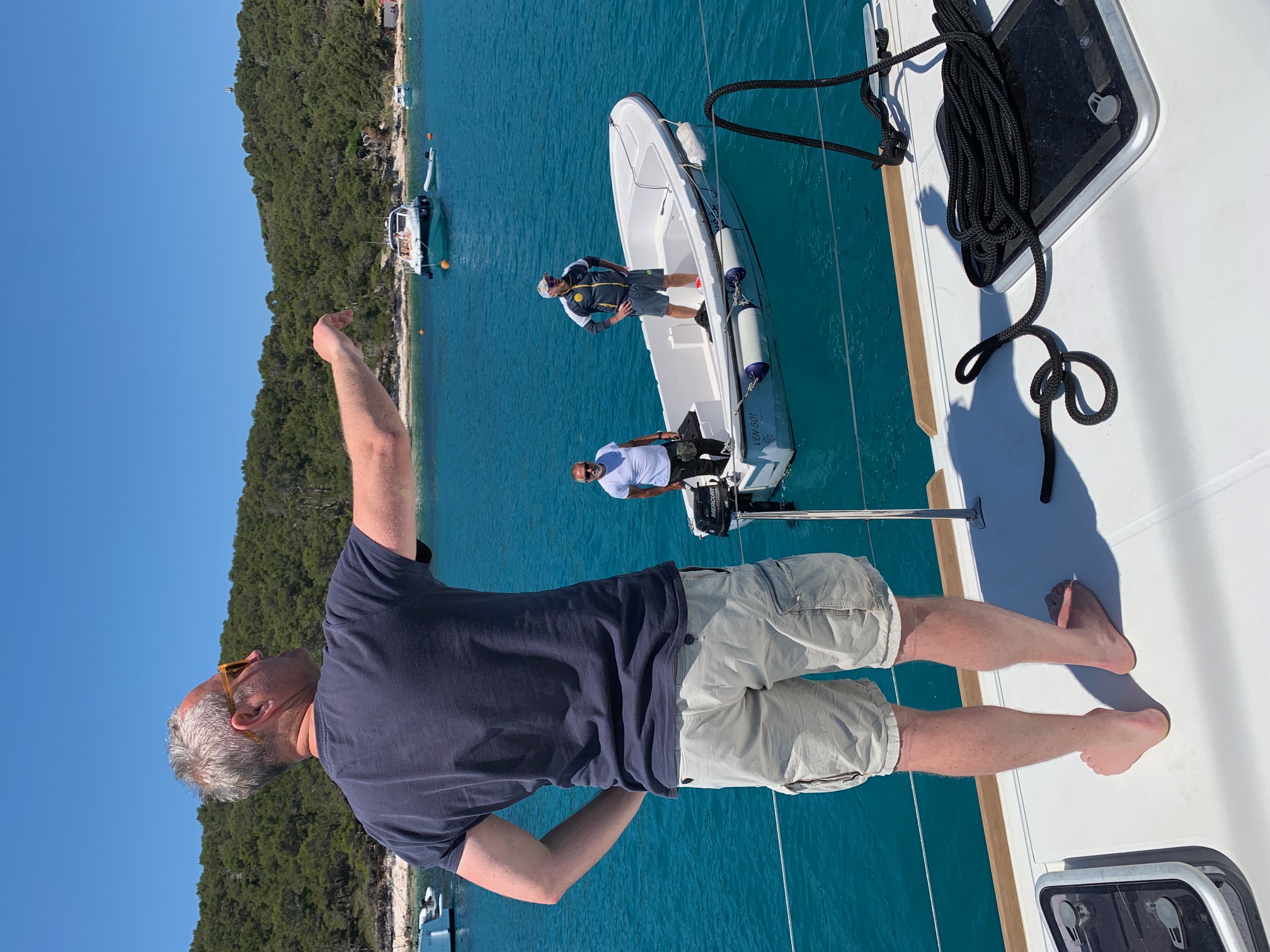 Danijel confirming our mooring buoy. All photos ©2021, Cyndie Burkhardt.
Danijel confirming our mooring buoy. All photos ©2021, Cyndie Burkhardt.
Learn more about Danijel’s yacht charters and catamarans, including trips to Greece.
Story and photographs ©2021, Cyndie Burkhardt. https://photo-diaries.com
Learn more at TCN’s Digital Nomads channel.
TCN now has a new resource in Total Croatia Sailing Page. Get answers and information about Croatia’s favorite pastime on the water.
Highlights of the Week: 5 Big Events in Croatia from June 20 - June 27, 2021
June 27th, 2021 - TCN's highlights of the week. A look at the events in Croatia from June 20 through the selection of TCN's intern Marina Kaleb.
Highlights of the week: Zagreb Digital Nomad Week 2021 Opens at Canopy by Hilton
Zagreb Digital Nomad Week 2021 & Zagreb Digital Nomad Ambassador Project kicked off the beginning of this week at Canopy by Hilton, one of 7 locations over 7 days, exploring 7 Digital Nomads related themes. The project is a collaboration between Saltwater Nomads, TCN, Doma Zagreb, the Digital Nomad Association Croatia, and the Zagreb Tourist Board (funded by the latter), and there was a high-profile turnout from the city and national officials to open the conference.

Croatia has been one of the more high-profile countries globally over the last year with its efforts to introduce the digital nomad permit, which came into effect on January 1, 2021. The 7 days each focused on the individual themes - cybersecurity, online presence, remote careers, tax & finance, the future of work, wellbeing, and explore Zagreb. The keynote speakers are a mixture of in-person and remote speakers.
Highlights of the week: Basketball Legend Magic Johnson Returns to Dubrovnik!
Magic Johnson's visit to Dubrovnik means he kept his promise of returning to the city. Johnson visited Croatia in the summer of last year. While strolling down Dubrovnik's main street Stradun he told a member of the media he finds the place beautiful and will be returning. Not even a year has passed, and he is once again seen smiling with his wife, Cookie, on one of Croatia's most beautiful streets.
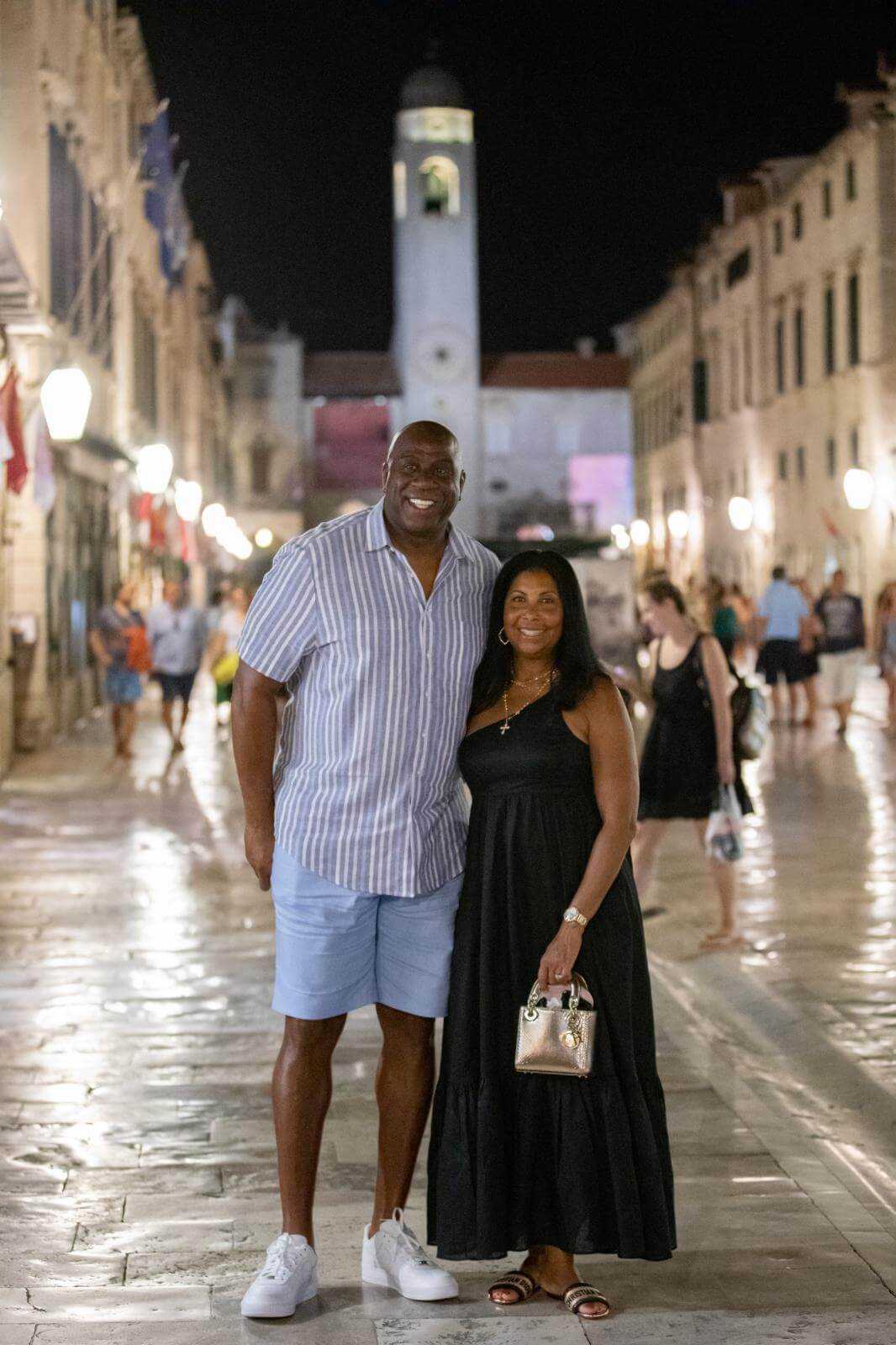
Grgo Jelavic/PIXSELL
It is unclear if Johnson will continue the trip to other parts of the country as he did last year. Low numbers of guests on the streets of Dubrovnik seem to be attracting plenty of wealthy tourists who do their best to avoid crowded beautiful destinations.
Highlights of the week: EURO 2020: Croatia Tops Scotland for 2nd Place in Group D and Round of 16 Spot!
Croatia tops Scotland 3:1 in the final Group D match for 2nd place and a spot in the Round of 16! The two nations played at Hampden Park in Glasgow on Tuesday night.
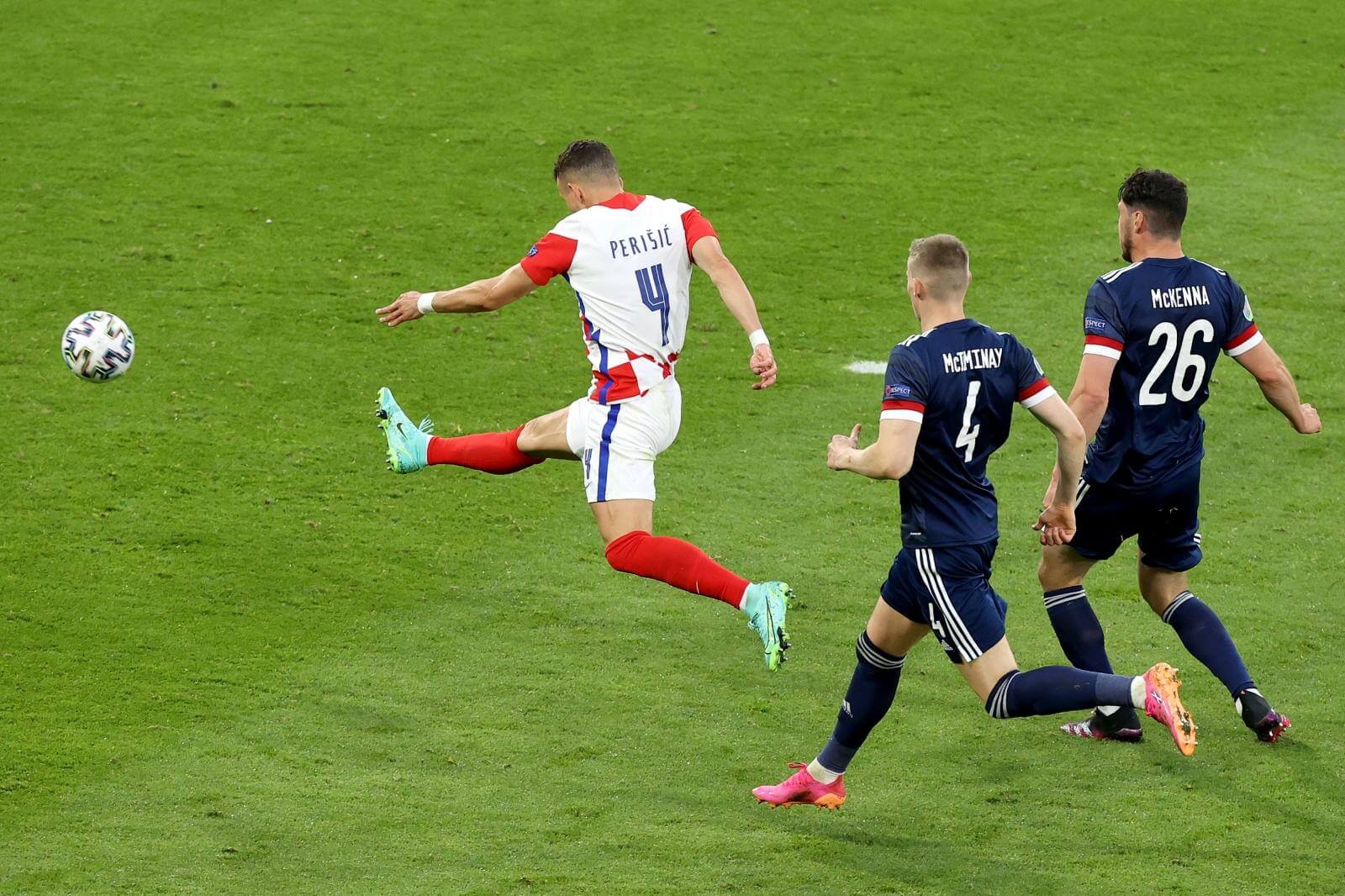
Goran Stanzl/PIXSELL
In the EURO 2020 round of 16, the Croatia national team will play against Spain on Monday night, the second-placed team from Group E in Copenhagen. Unfortunately, the Croatian national team will play without Ivan Perišić, who tested positive for Covid-19 just before the game. Ivan Perišić could not play before the EURO final on July 11th at Wembley Stadium. We wish him an uneventful recovery and returning to football at Wembley on that day, with Croatia in the finals!
Highlights of the week: EURO 2020: Croatian Female Team Wins 3 Medals at EGOI: Amazing Results at First Female-Only European Informatics Olympics
Ema Borevković, Lina Krištić and Lara Semeš (from Zagreb's XV Gymnasium), and Martina Licul (Pulau Gymnasium) represented Croatia and the aftermath of the contest that gathered 157 contestants saw Ema winning a gold medal, while Lara and Martina grabbed silver medals for their results.
Pixabay
The contest was held online due to Covid-19 measures. The organization of the event for Croatian was arranged by the Croatian Computer Science Association (CCSA), and Zagreb's XV Gymnasium was the host of the event, where the studnets took the tests.
Highlights of the week: Lorde Returns to Her Roots for 2022 St. Michael's Fortress Spectacle in Šibenik
At an extremely exclusive concert with only 1,050 tickets on sale, the New Zealander with Croatian roots will recall some of her mega-hits from the first two albums and present "Solar Power," which will be released later this summer. Born in New Zealand, her mother has Dalmatian roots, and Lorde herself has dual citizenship.
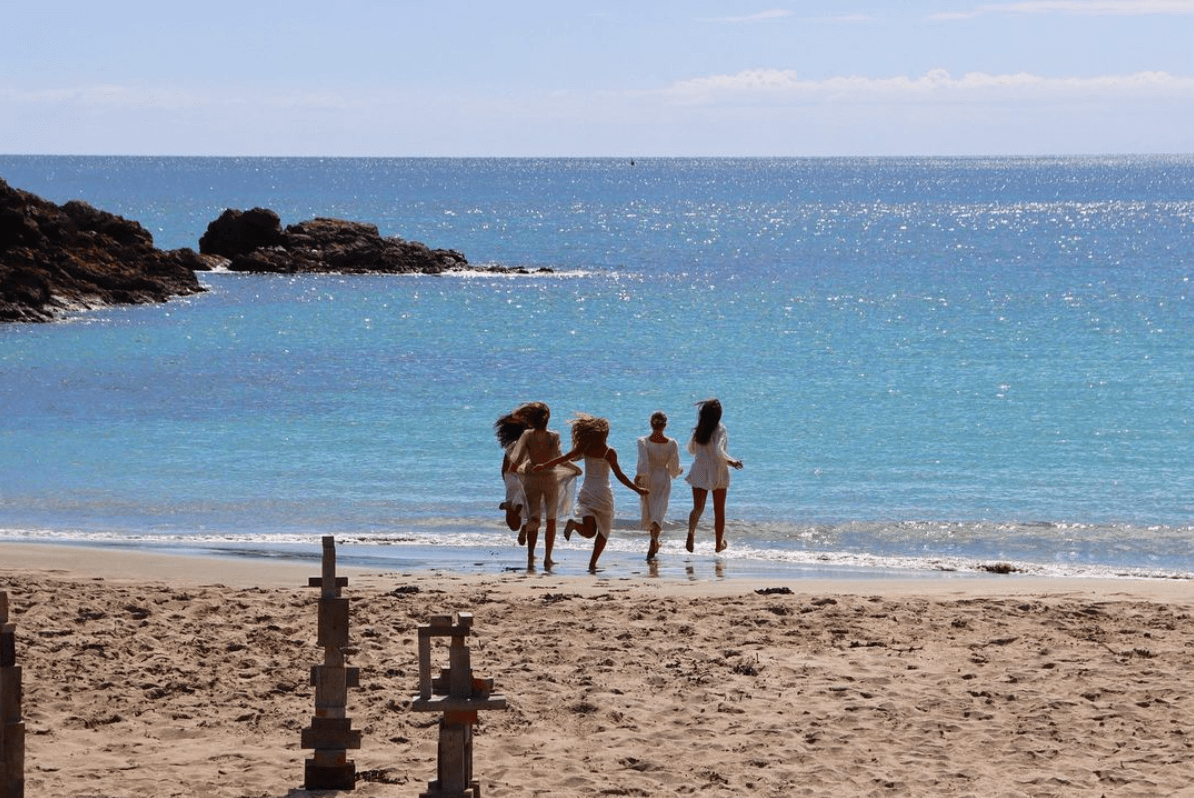
Lorde Instagram
On tour, Lorde plays in locations she personally chooses and wants to visit, mostly the best concert stages in the world. Thus, the special Šibenik fortress found itself on the list in the company of legendary concert destinations such as Radio City Music Hall in New York, Shrine Auditorium in LA, Roundhouse in London, or Castello di Villafranca in Verona.
For more on events in Croatia, follow our dedicated lifestyle section.
For more about education in Croatia, follow TCN's dedicated page.
To follow the rest of the TCN coverage of the Euro 2020, click here.
For the latest news and features od digital nomads in Croatia, check out the dedicated TCN section.
5th Day of Zagreb Digital Nomad Week and Beginning of Ambassador Program
June 26, 2021 - A look at the 5th day of Zagreb Digital Nomad Week and the first digital nomad ambassador!
The announcement of Veronica Mulhall as the ambassador of 'Zagreb Digital Nomads' concluded the fifth day of 'Digital Nomad Week' on Friday, where the organizers Saltwater Nomads, Total Croatia News, and the Zagreb Tourist Board presented the advantages, opportunities, and possibilities of the Croatian capital for remote digital nomad work, reports Jutarnji List.
In July, Veronica Mulhall will be the first ambassador - a digital nomad who will work and live in Zagreb for a month.
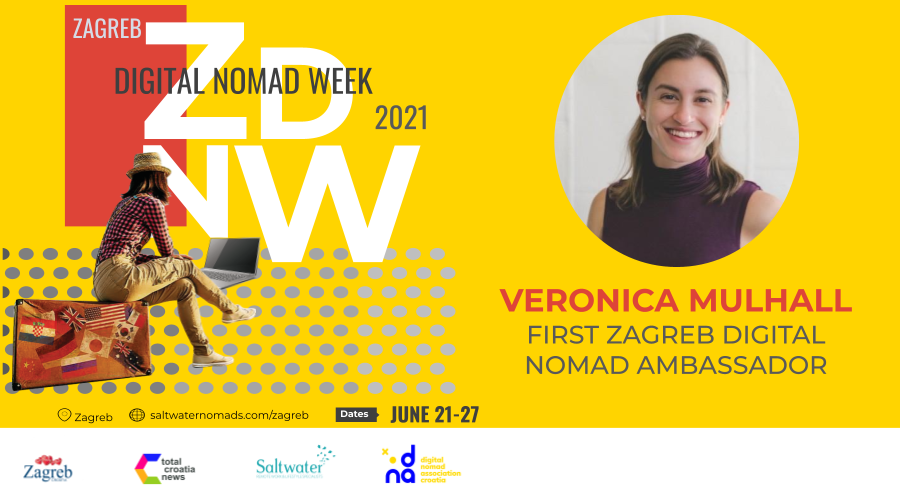
"Congratulations to Veronica on this election, Zagreb welcomes her, and I think she will have a wonderful time in our city; that is, she will have great opportunities to find her new job office here. We will introduce her to everything that Zagreb has to offer digital nomads," said Petra Maršić Buljan from the Zagreb Tourist Board.
The 'Zagreb Digital Nomads' ambassador was preceded by three 'Digital Nomad Week' panels which analyzed future trends in the labor market, digital nomads as a solution to changes in the labor market, and Croatian policies in accepting and deepening global trends in teleworking.
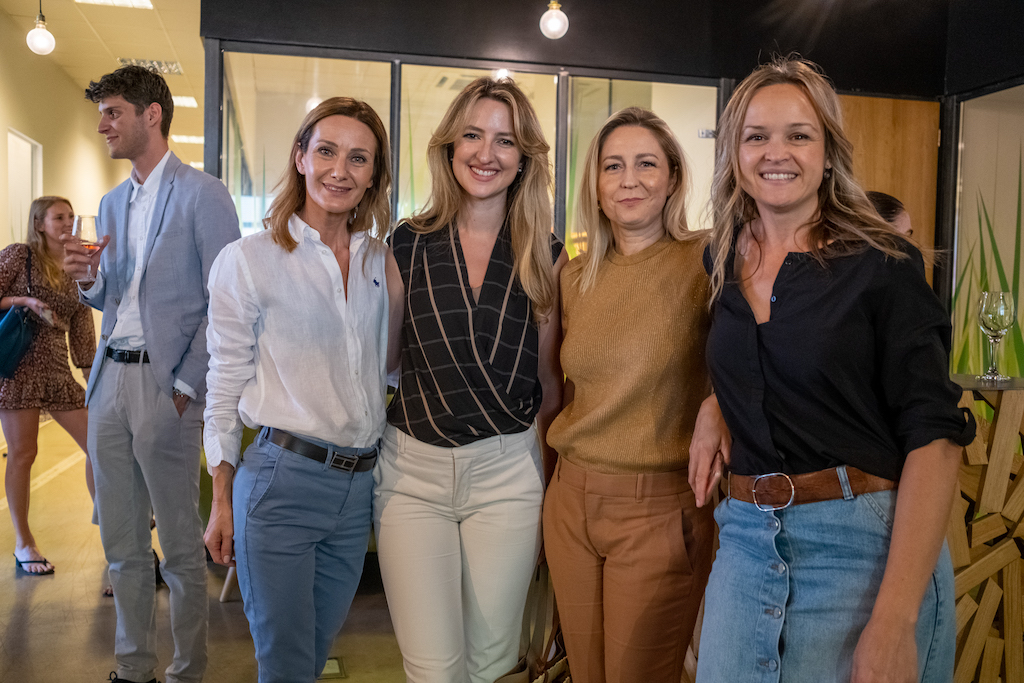
Jose Alfonso Kusijanović
Before the panels, the participants were given a lecture by blogger and labor market researcher Albert Canigueral on the future of work.
"The future of work has three dimensions, the future of the job itself, the job and the fulfillment of business tasks or goals. Nomads are one of the solutions for the future of the workplace, and how far we have come in applying this way of working is evidenced, among other things, by the example of employers in the Swedish transport business who are committed to regulating the work of truck drivers from home," said Canigueral. He recalled the thesis of the famous sociologist Peter Drucker that the basic question of the labor market is not to find answers to the demands that arise but to ask a key question of the labor market.
After Canigueral’s presentation, the first three panels of the ‘Digital Nomad Week’ closing day entitled ‘Sustainable and Self-Renewing Destinations’ followed. In addition to moderations by Ron Tardiff, the director of the Zagreb Tourist Board Martina Bienenfeld, the director of the Dubrovnik Tourist Board Ana Hrnić, the author of numerous travelogues Anja Mutić, and the entrepreneur in tourism Daniel Lacko spoke about sustainable and self-renewing tourist destinations.

Ron Tardiff, one of the winners of the last Dubrovnik Digital Nomads in Residence competition, discussed Sustainable and Regenerative Destinations with a panel that included Martina Bienenfeld, CEO of the Zagreb Tourist Board. (Jose Alfonso Kusijanović)
Ana Hrnić pointed out that the tourist season in the pearl of Croatian tourism in Dubrovnik is currently under the strong influence of last year's consequences of the coronavirus and large restrictions in air traffic on Dubrovnik tourism, which, she warned, is an air destination. On the other hand, the Dubrovnik Tourist Board director pointed out that 2019 was a record year in terms of visiting guests for Dubrovnik tourism.
"In 2019, we took the first steps to ensure the long-term sustainability of Dubrovnik tourism, limiting the number of cruiser arrivals in the city port," said Ana Hrnić. Martina Bienenfeld reminded that the Zagreb tourist offer in 2020, in addition to COVID-19 and lockdown, also faced a devastating earthquake.
"I must emphasize that we have not given up our efforts to prove that we are still 'alive' as a tourist destination, and we have done many great projects and campaigns since the beginning of the pandemic. I want to remind you that Zagreb changed, and we do not give up with new stories, new projects, highlighting some of the projects such as Pimp my Pump, Mali Zagreb and Triptych. When it comes to the sustainability of the city's tourist offer, we try to prove that Zagreb is not only the capital of a beautiful tourist country but a great place to live and work," said Martina Bienenfeld.
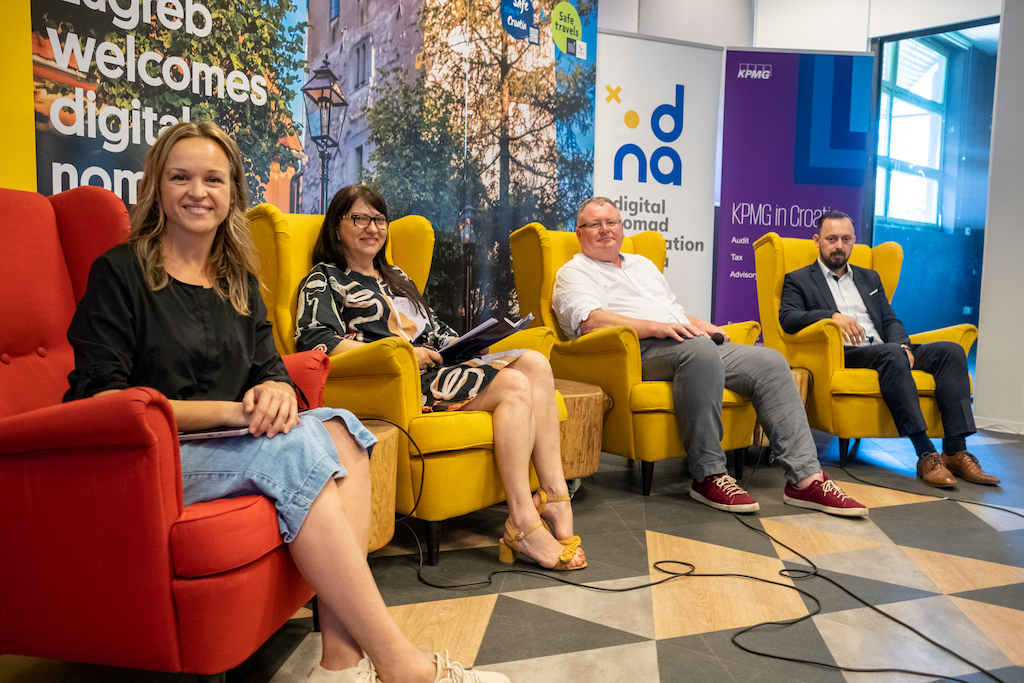 Tanja Polegubić, organizer of Zagreb Digital Nomad Week, moderated a panel consisting of Petra Maršić Buljan from the Zagreb Tourist Board, Paul Bradbury from Total Croatia News, Dalibor Kovačević from Raiffeisen Bank Hrvatska, and Matthew Parsons from Skift. The theme was Future of Work Trends and Croatia's Global Standing. (Jose Alfonso Kusijanović)
Tanja Polegubić, organizer of Zagreb Digital Nomad Week, moderated a panel consisting of Petra Maršić Buljan from the Zagreb Tourist Board, Paul Bradbury from Total Croatia News, Dalibor Kovačević from Raiffeisen Bank Hrvatska, and Matthew Parsons from Skift. The theme was Future of Work Trends and Croatia's Global Standing. (Jose Alfonso Kusijanović)
The first panel was followed by a conversation between the moderator of ‘Digital Nomad Week’ Michael Freer, and Mandy Fransz, the founder of the company ‘Digital Leap’ for Digital Transformation.
"I heard about Croatia as a digital nomad destination, came here, and was convinced that Croatia provides a lot of events, but also opportunities for community development, which I consider the most important part of my job," said Mandy Fransz.
In the second panel, moderated by Tanja Polegubić from Saltwater Nomads, Petra Maršić Buljan from the Zagreb Tourist Board, Paul Bradbury, CEO of Total Croatia News, editor of the Skift portal Matthew Parsons and Dalibor Kovačević from Raiffeisenbank. This was followed by a presentation by Dean Kuchel, who introduced himself to the participants as a nomadic lifestyle ambassador.
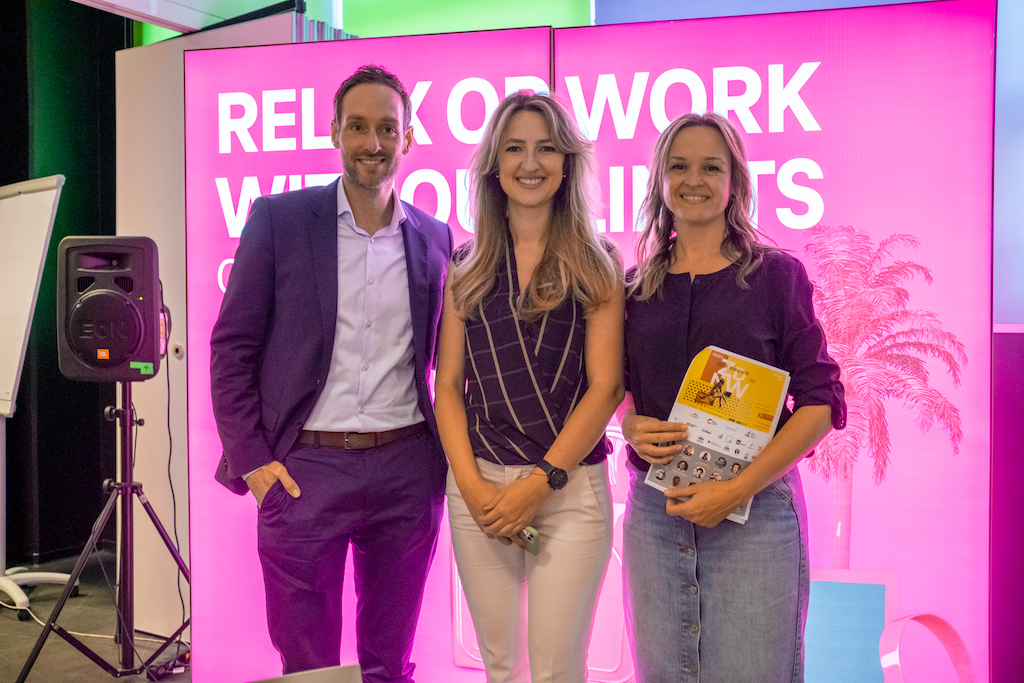
Jan de Jong (Digital Nomads Association), Nikolina Pejović (Hrvatski Telekom) and Tanja Polegubić (Saltwater Nomads). (Jose Alfonso Kusijanović)
The last panel of the fifth day featured Jan de Jong, an entrepreneur who initiated the digital nomad visa in Croatia, Kristina Grbavac from the auditing company KPMG, Branka Bajt Hrvatski Telekom, and Hermes Arriaga Sierra from Impact Hub.
Asked by panel moderator Michael Freer how he came up with the idea to initiate the introduction of digital nomad visas in our country, Jan de Jong said that at his first participation in a conference on Croatian tourism, he faced the question of how to make Croatia a year-round tourist destination. The answer to the latter question, Jan de Jong, as he said, was given in the texts of Paul Bradbury on the portal Total Croatia News.
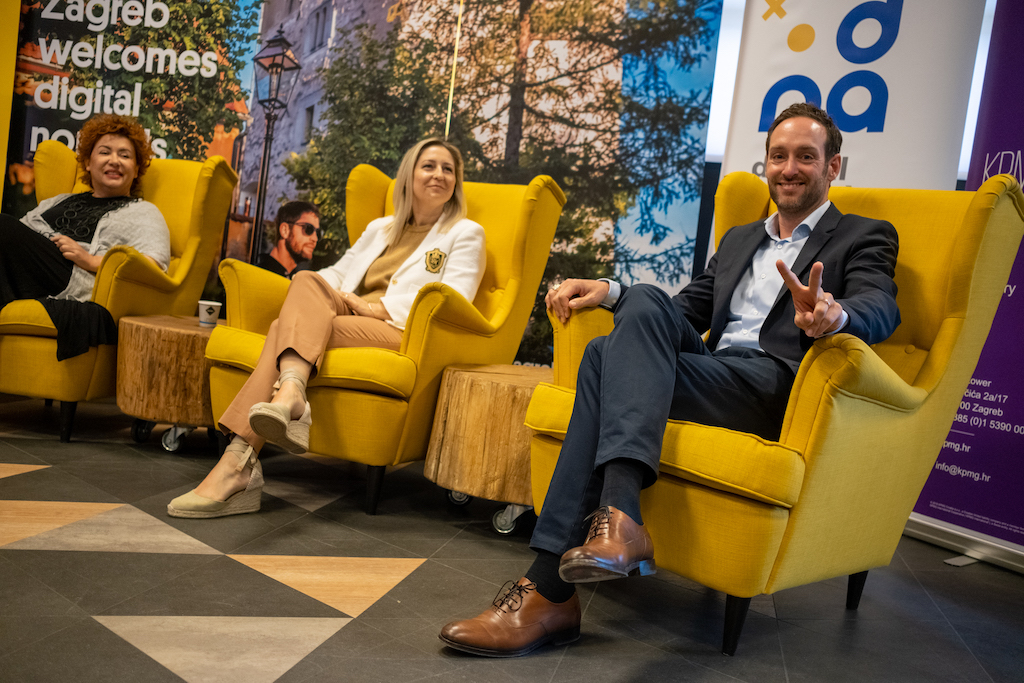
In the third and final panel, moderated by Michael Greer, Branka Bajt from Hrvatski Telekom, Kristina Grbavac from KPMG, Jan de Jong from DNA Croatia, and Hermes Arriaga Sierra from Impact Hub discussed about DNA Croatia, Policy, and Connecting a Global Community. (Jose Alfonso Kusijanović)
"In Paul’s texts, three words shone on me, digital nomad tourism. Then I started to promote this concept in my public speeches, finding great support from the followers of my speeches, but, very soon after, almost all major media in the country," said de Jong, revealing that after they received support for the development of digital nomad tourism from the Croatian Government, i.e., the Office of the Prime Minister. We managed, de Jong, concluded that Croatia becomes one of the top ten countries in the world with a visa for digital nomads. De Jong continues to implement his idea through the DNA Croatia association.
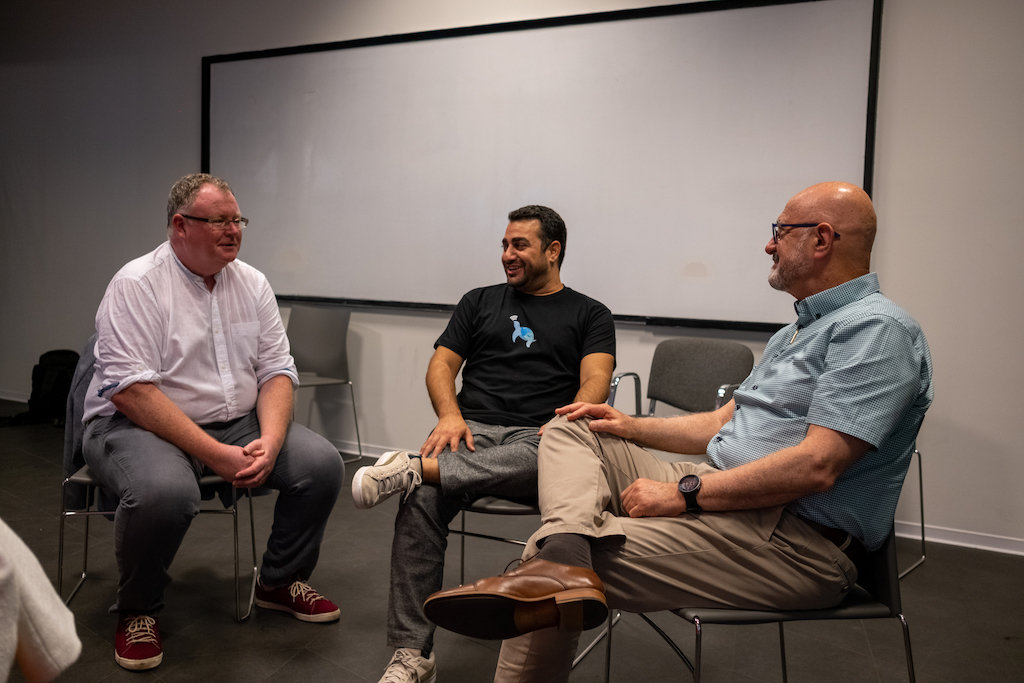
Paul Bradbury, Total Croatia News CEO, talks to Dean Kuchel, who spoke about Community Building, and Israel's Ambassador to Croatia, Ilan Mor. (Jose Alfonso Kusijanović)
"One of the DNA Croatia association goals is to extend the visa from the current six-month residence permit for digital nomads. We also want to simplify the procedures regarding the taxation of digital nomads," announced Jan de Jong.
Meet one of Friday's keynote speakers, Albert Cañigueral, one of the Dubrovnik nomads-in-residence and recently appointed to lead the Catalan Government's Transparency and Open Data, division. Albert will be focusing on the topic of the day, the future of work.
Tourist Board Director Martina Bienenfeld on Zagreb Digital Nomad Week, Ryanair, Tourism in Pandemic
For the latest news and features on digital nomads in Croatia, check out the dedicated TCN section.



